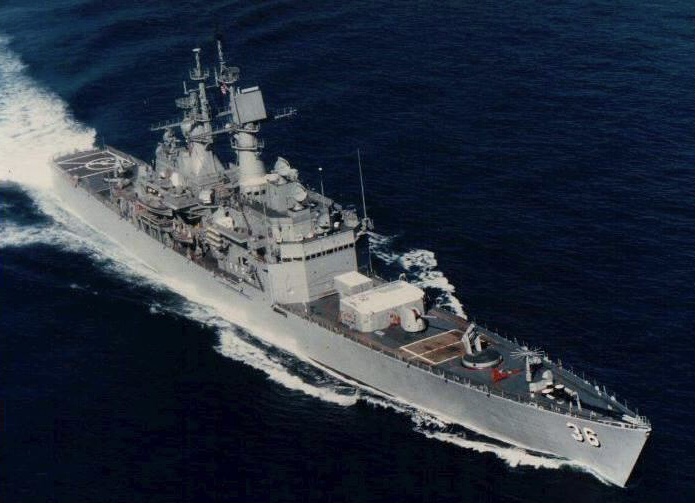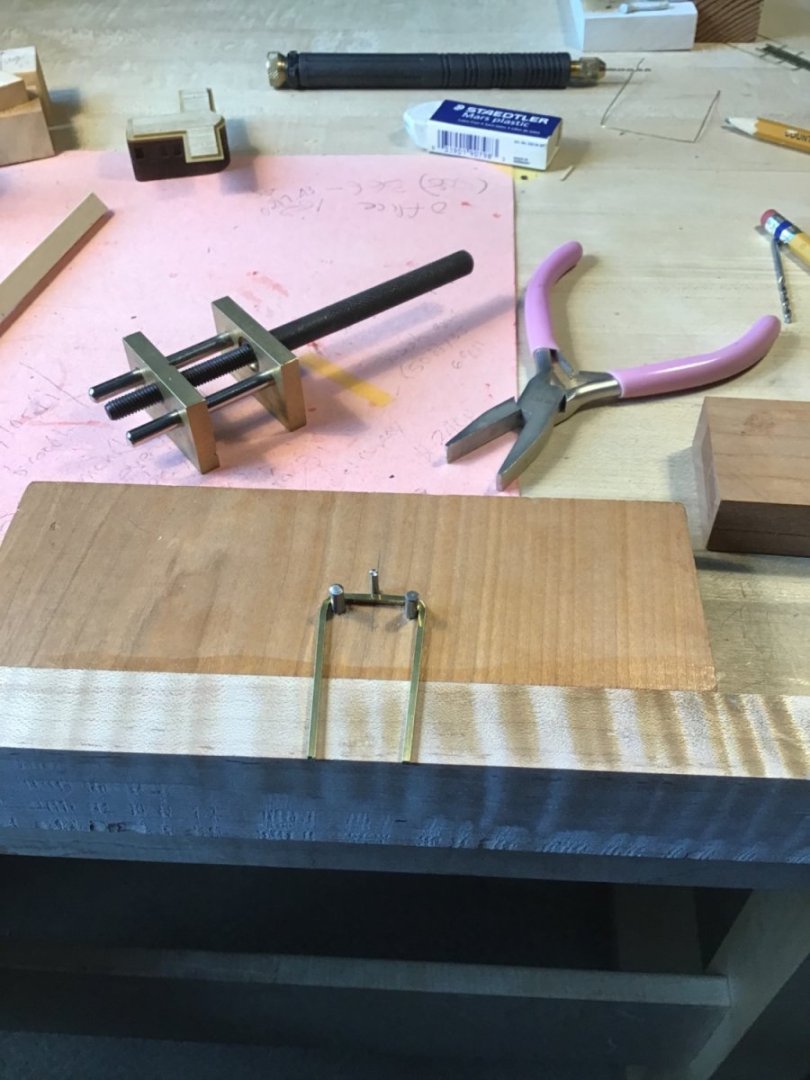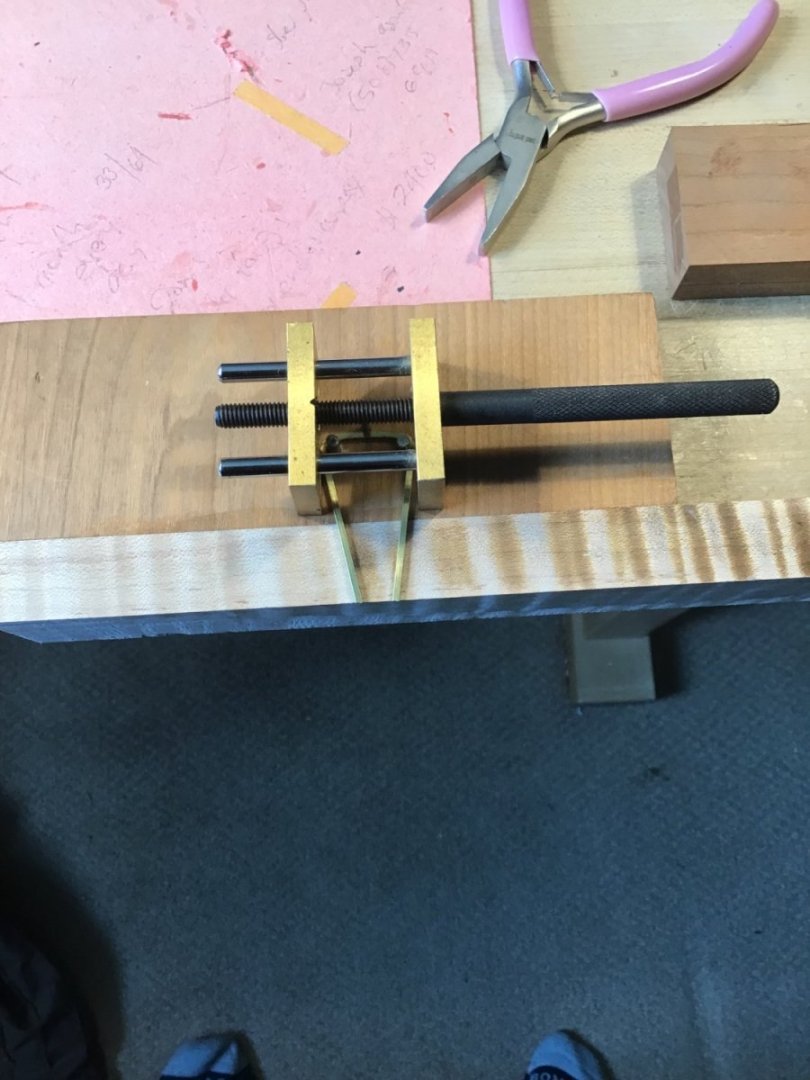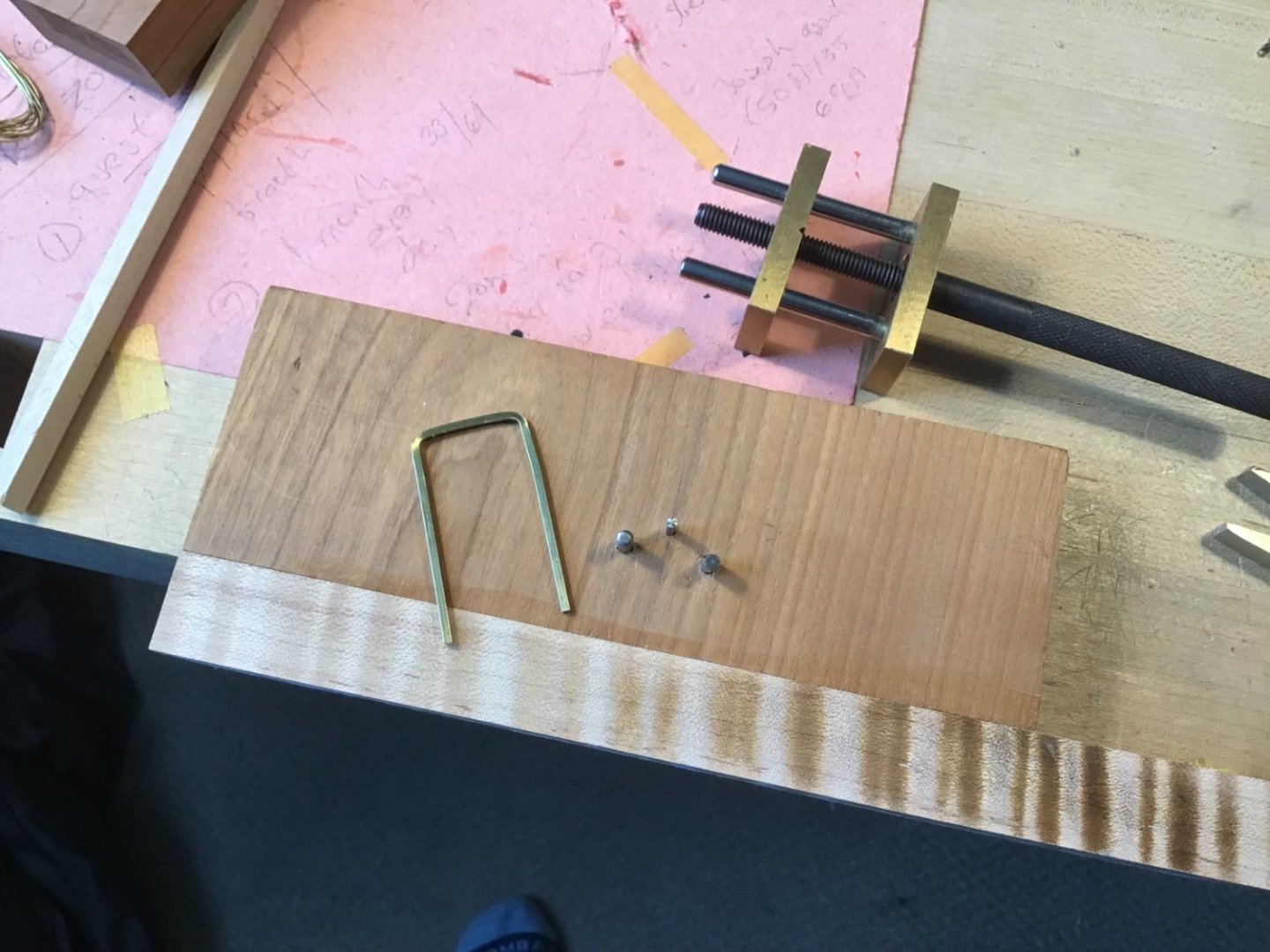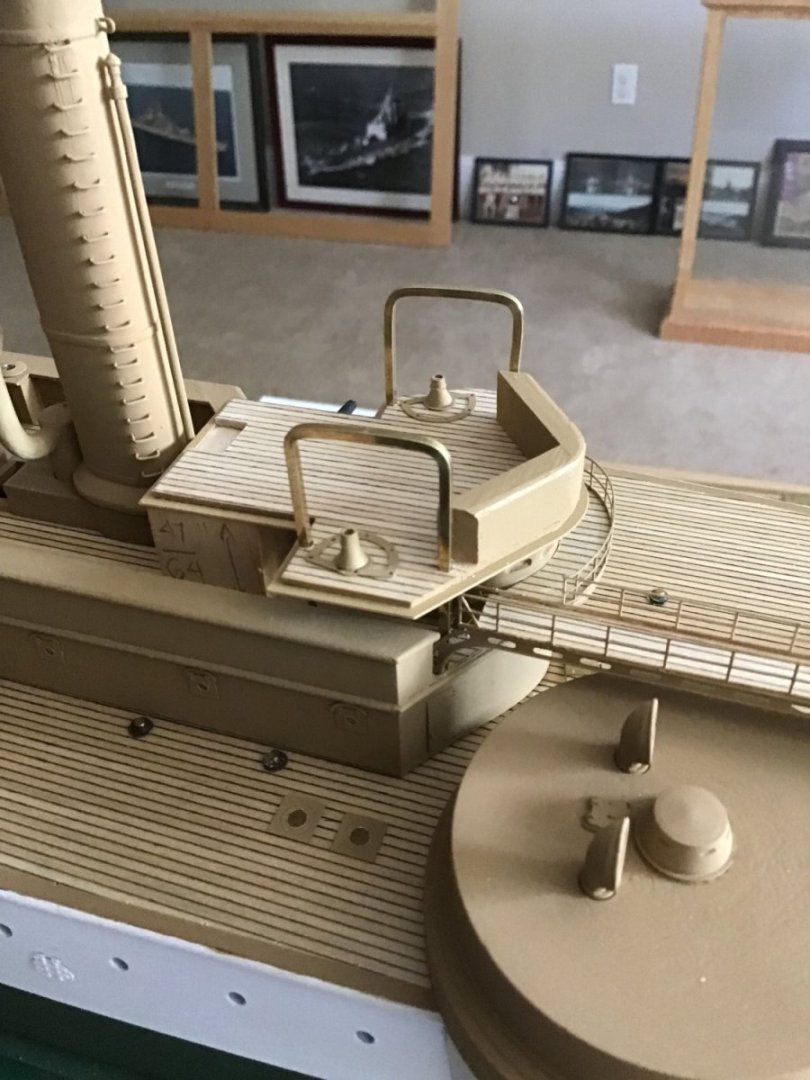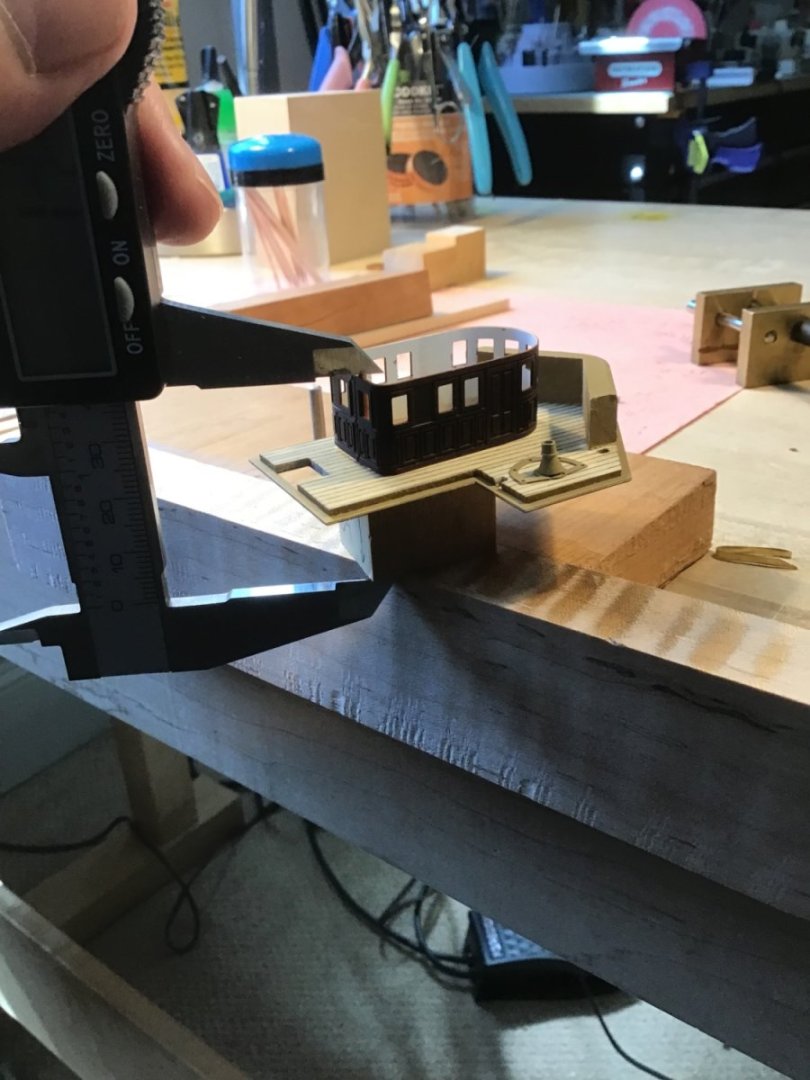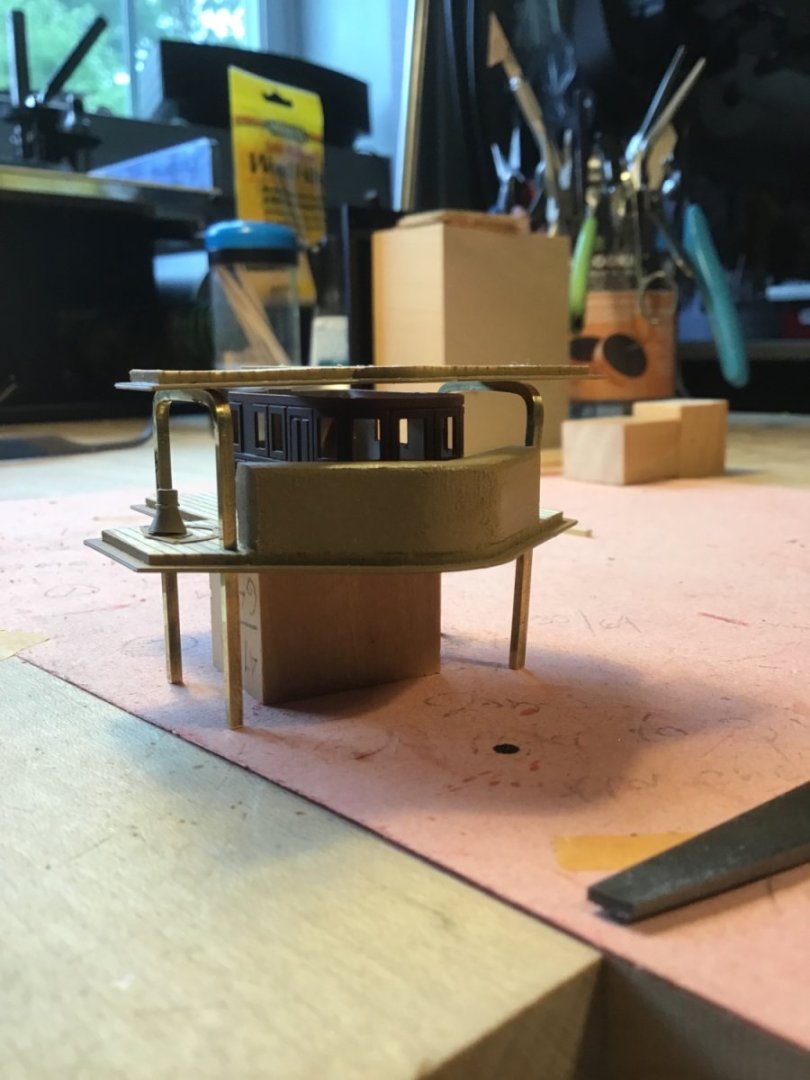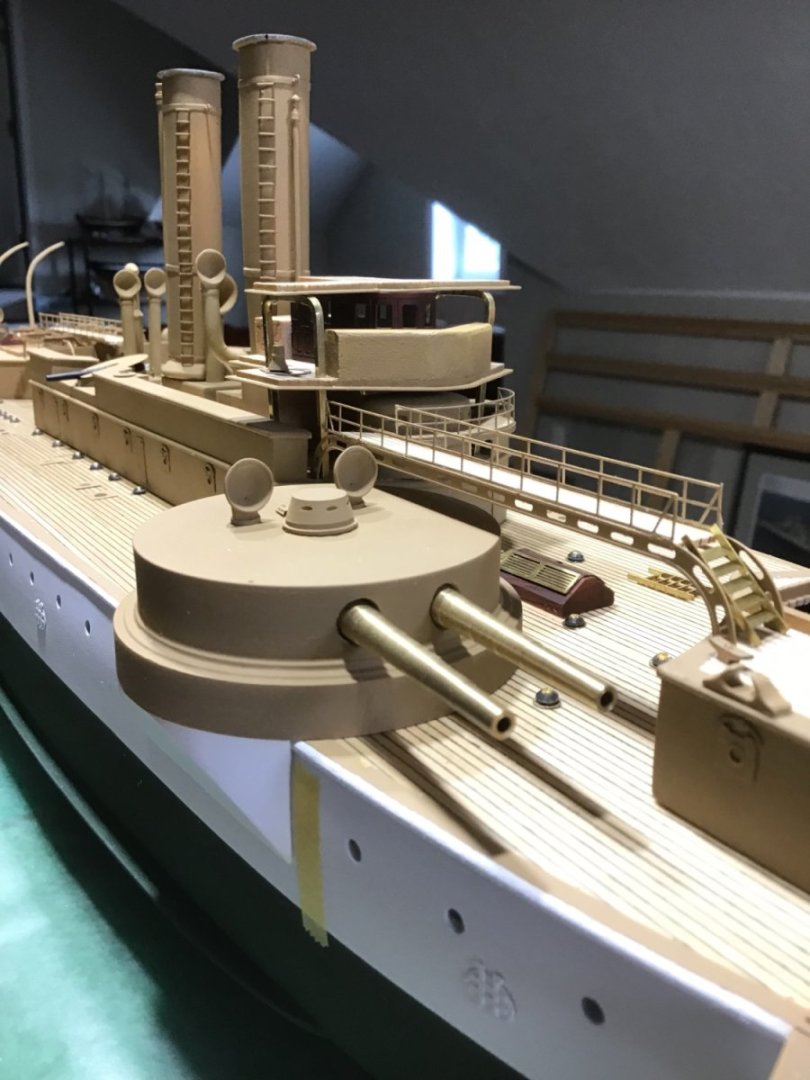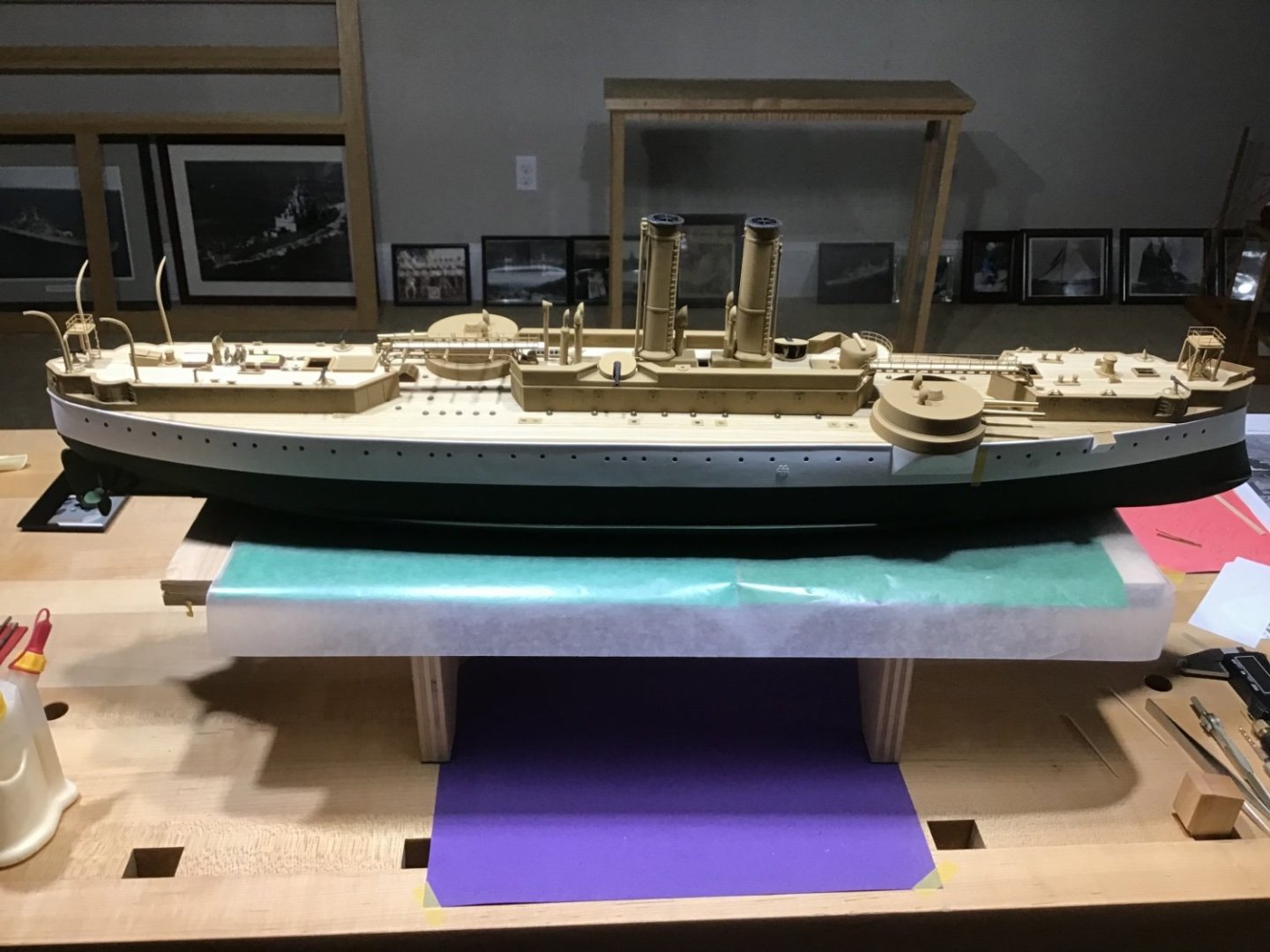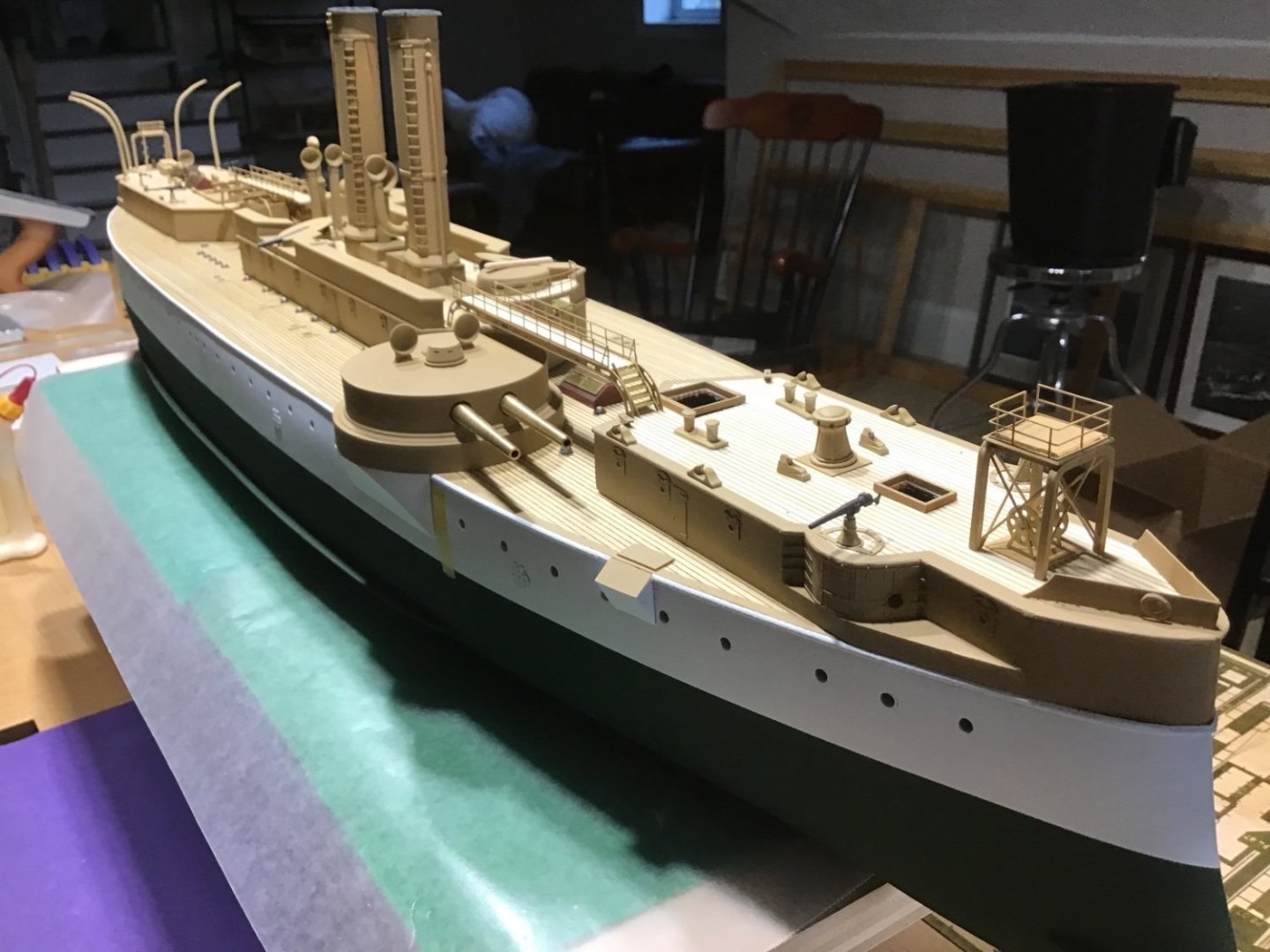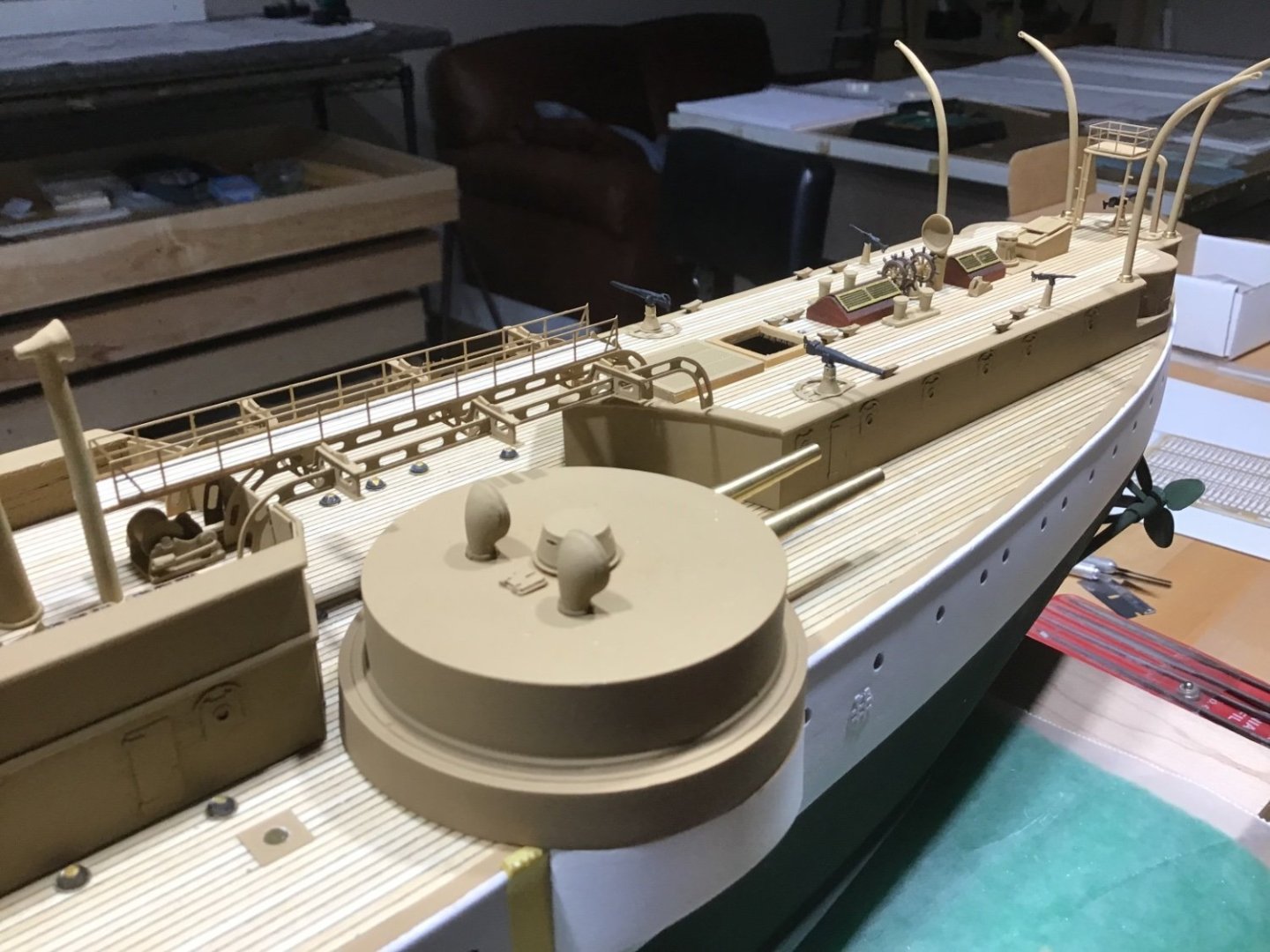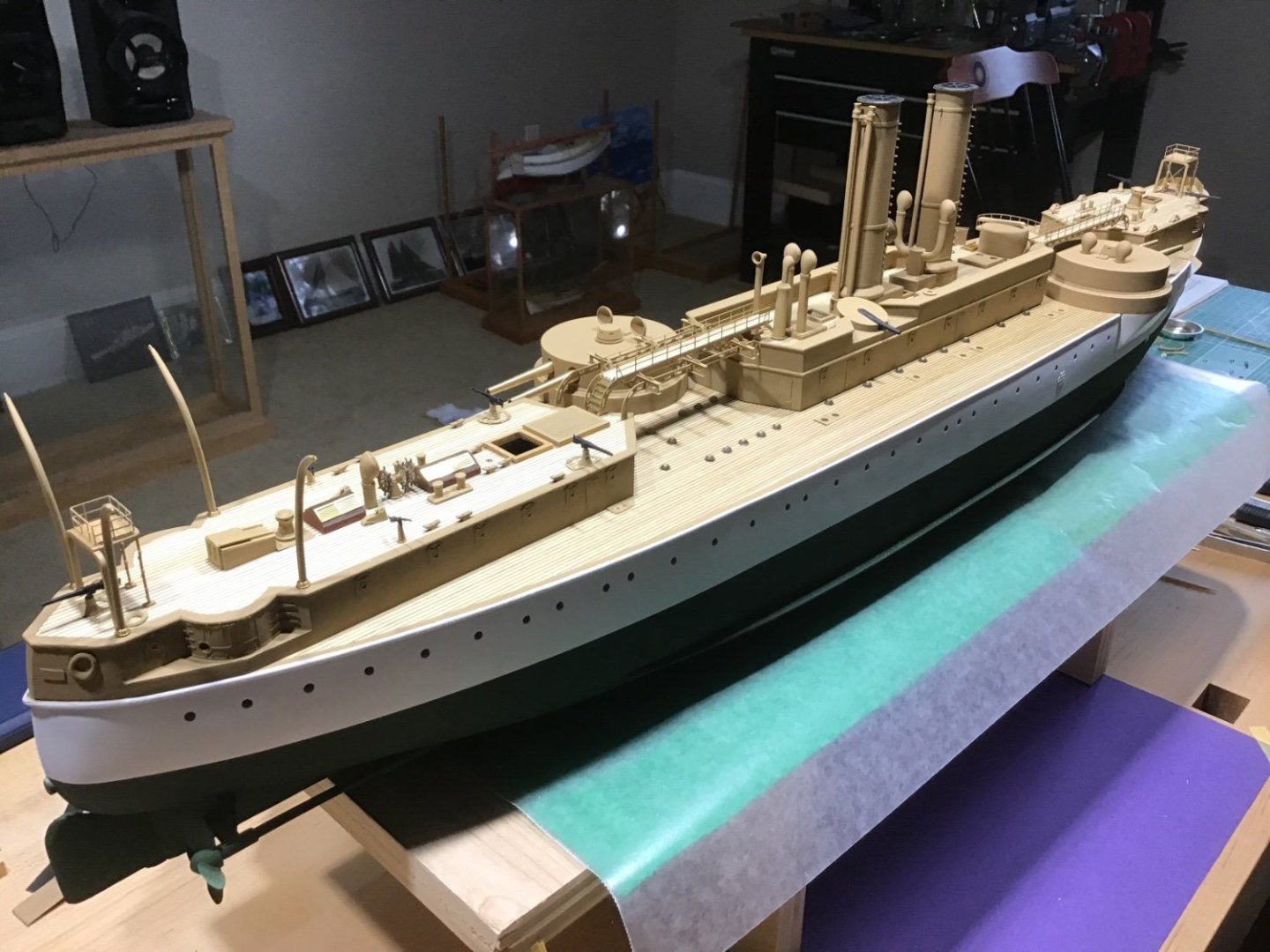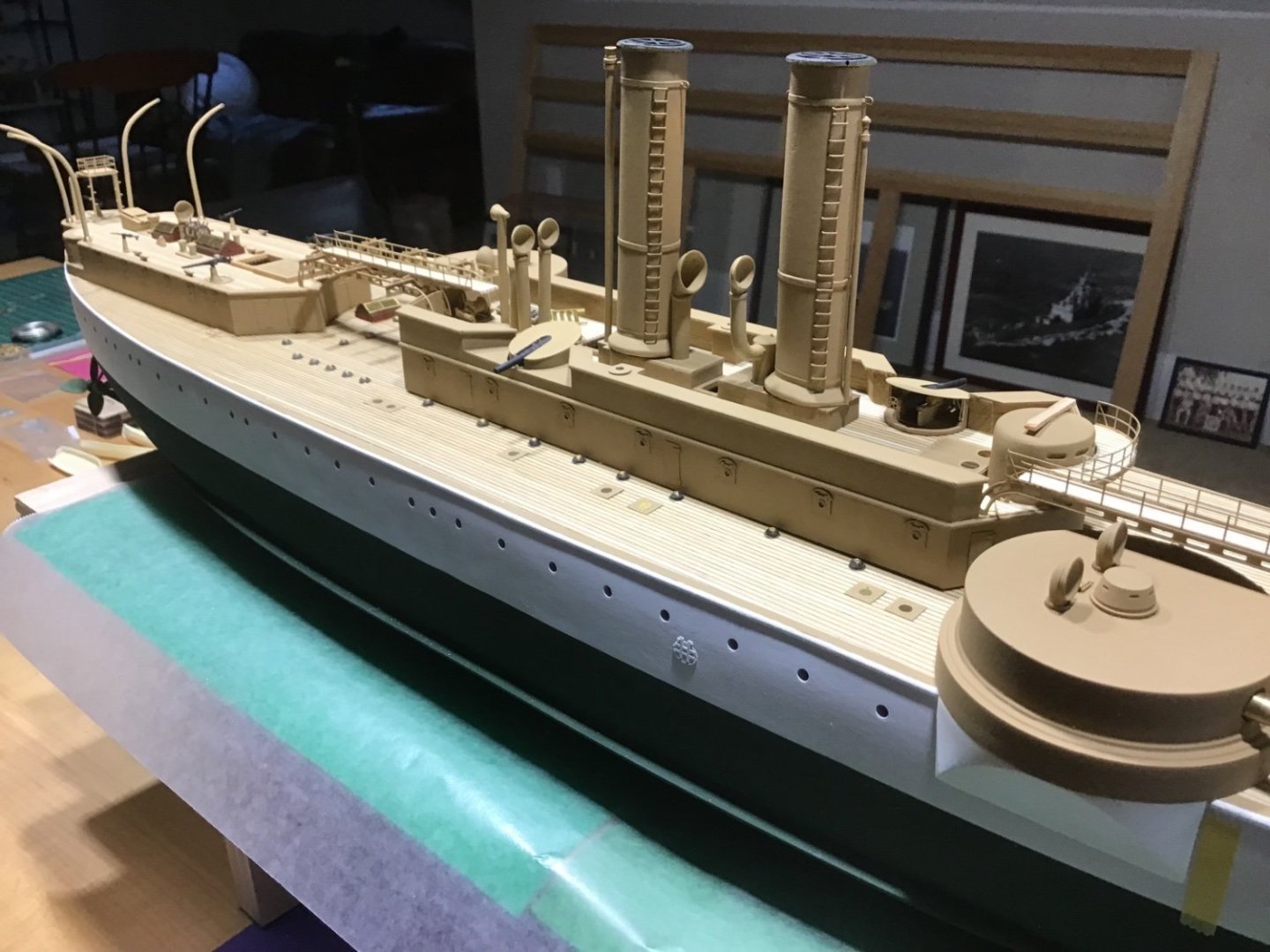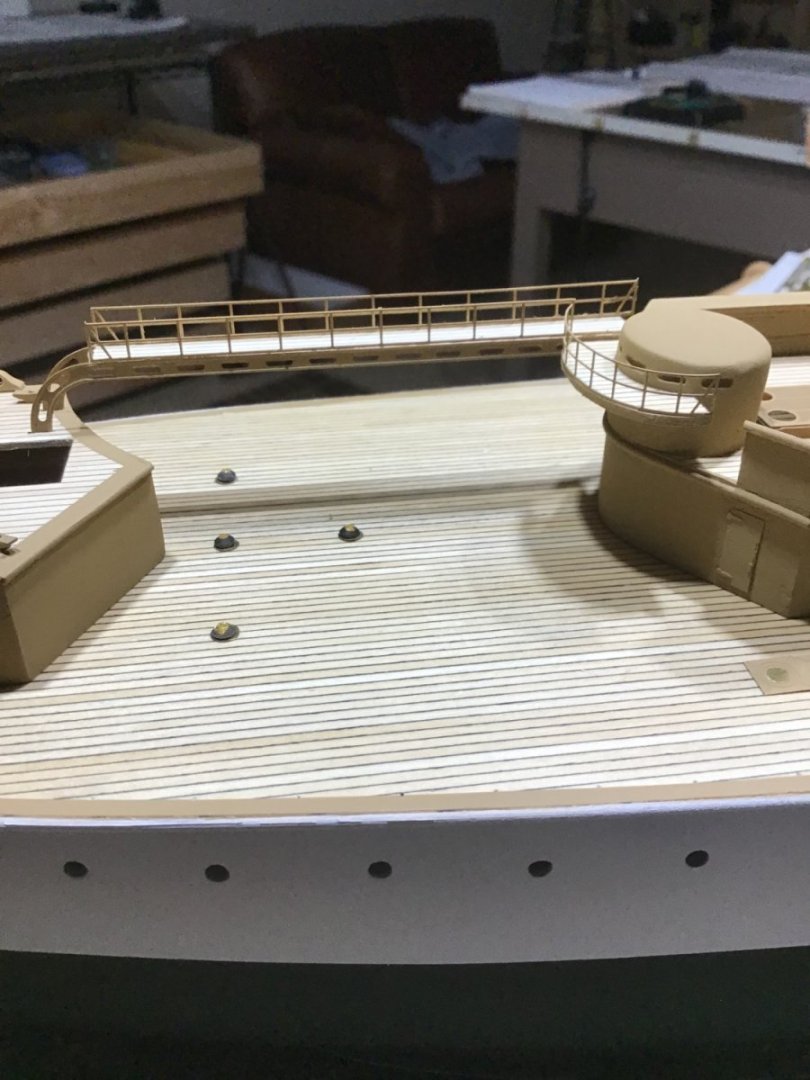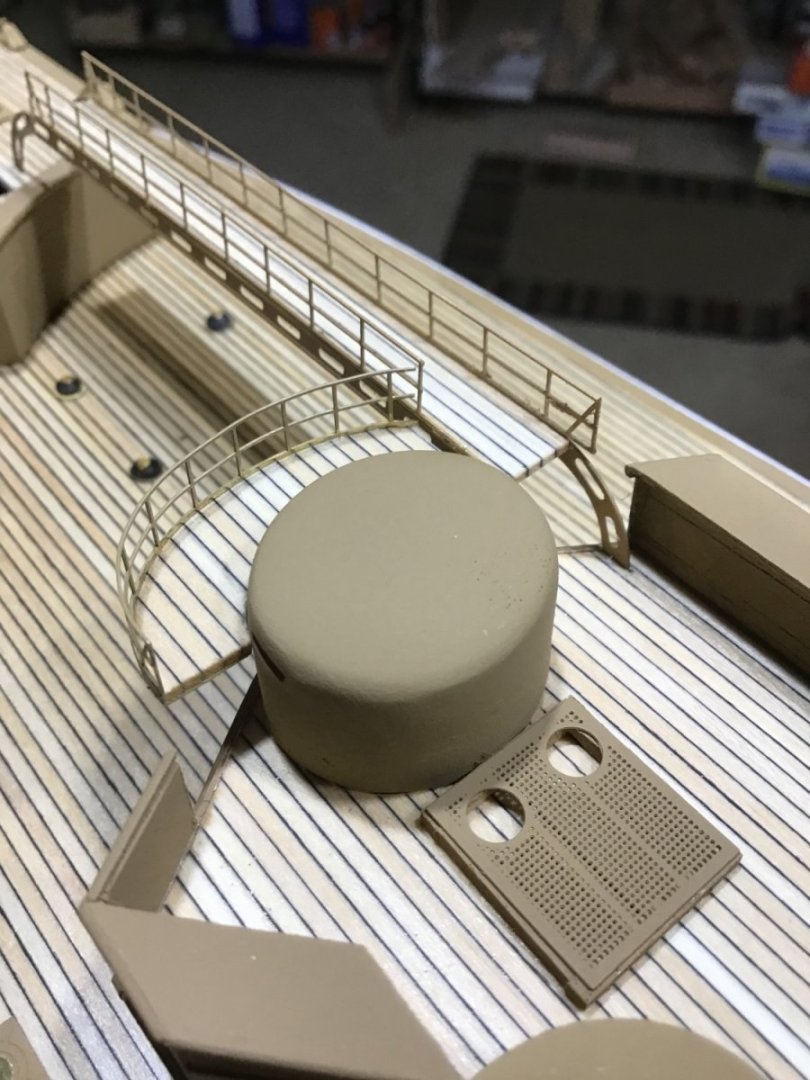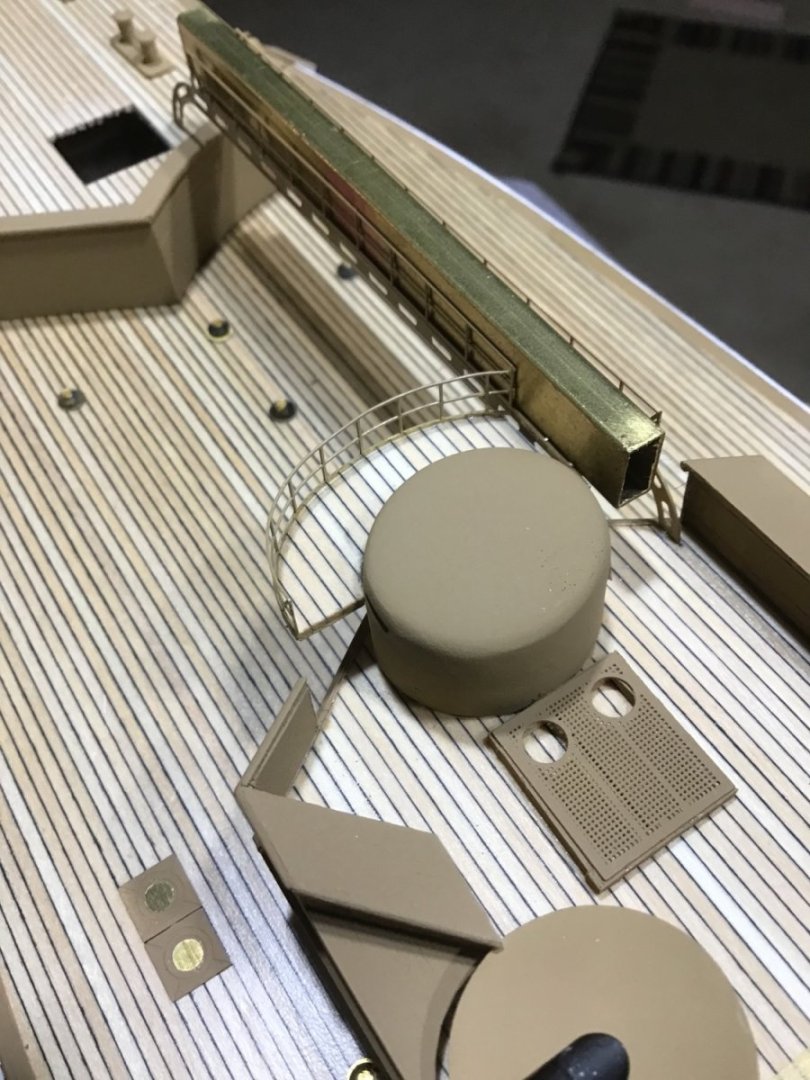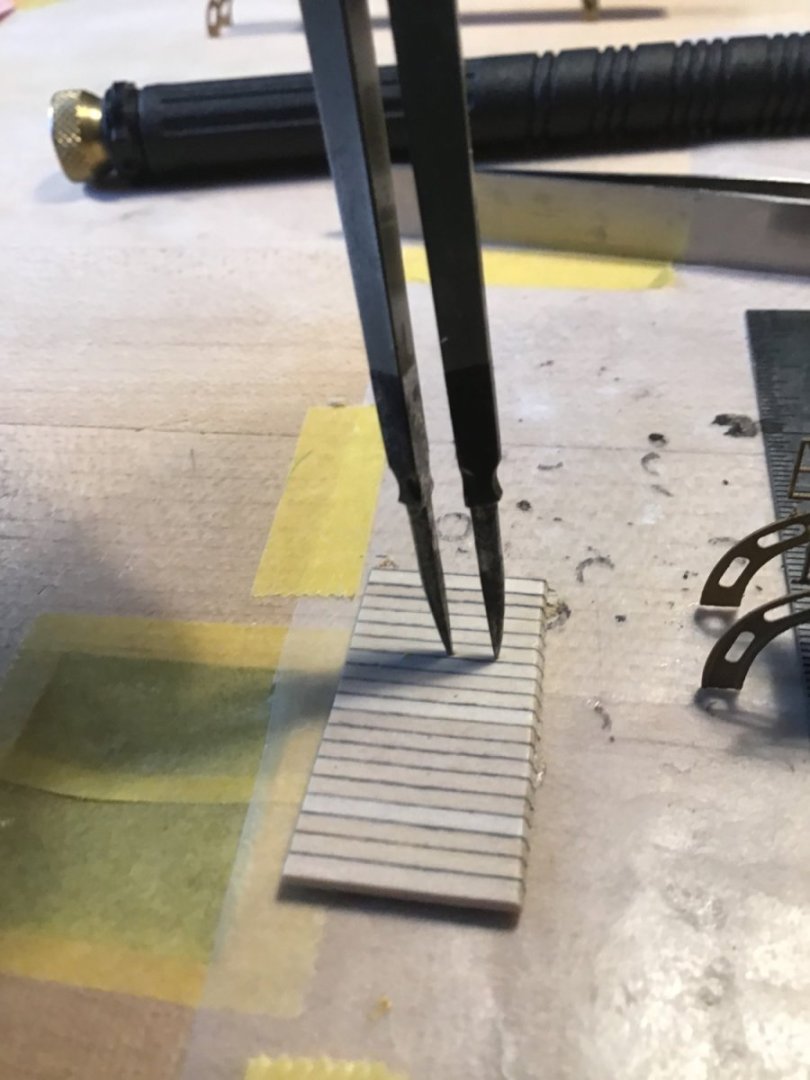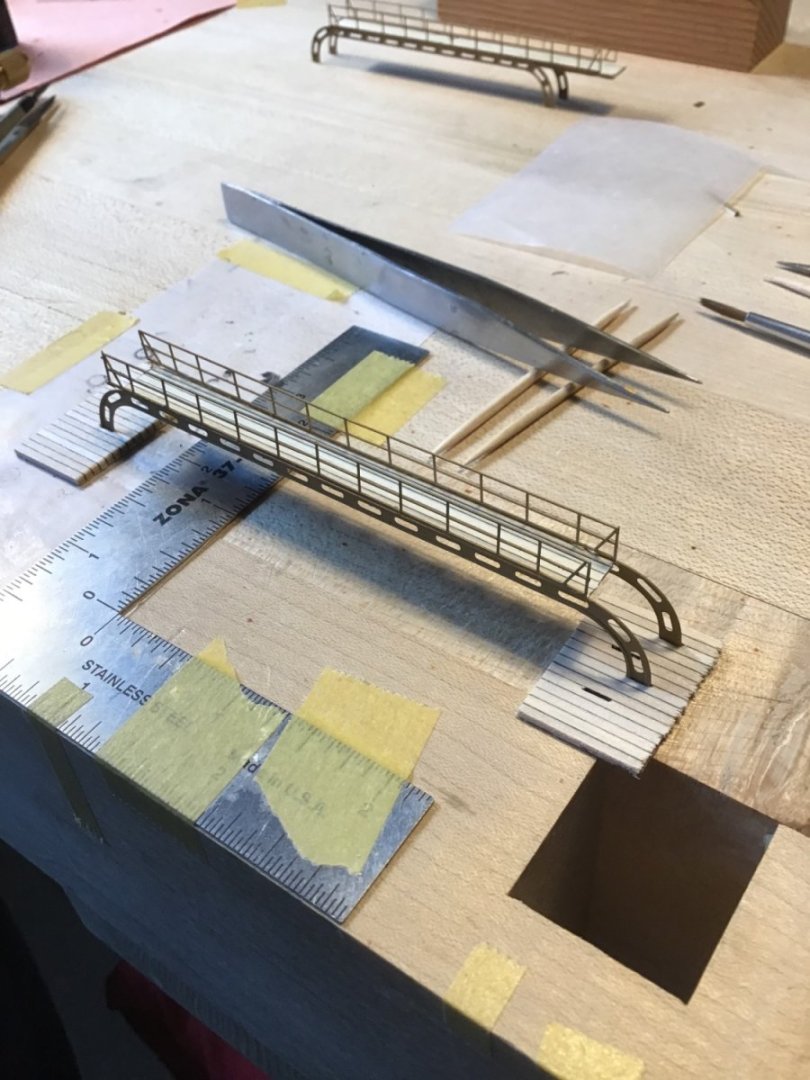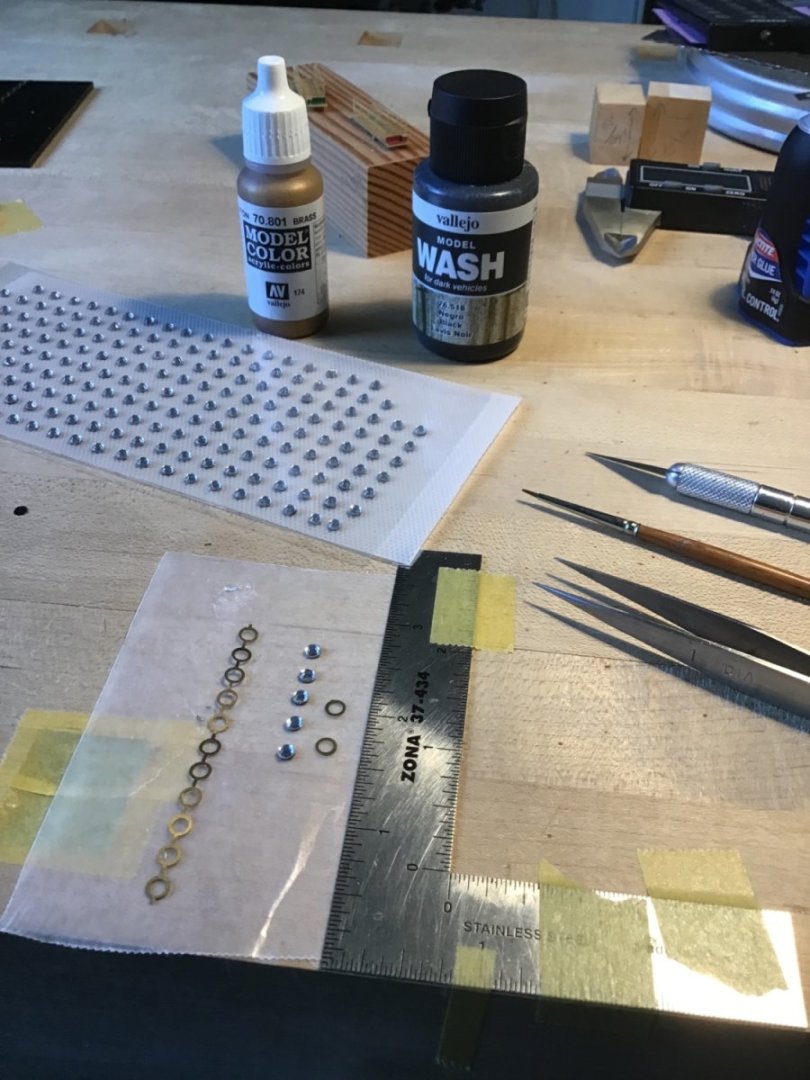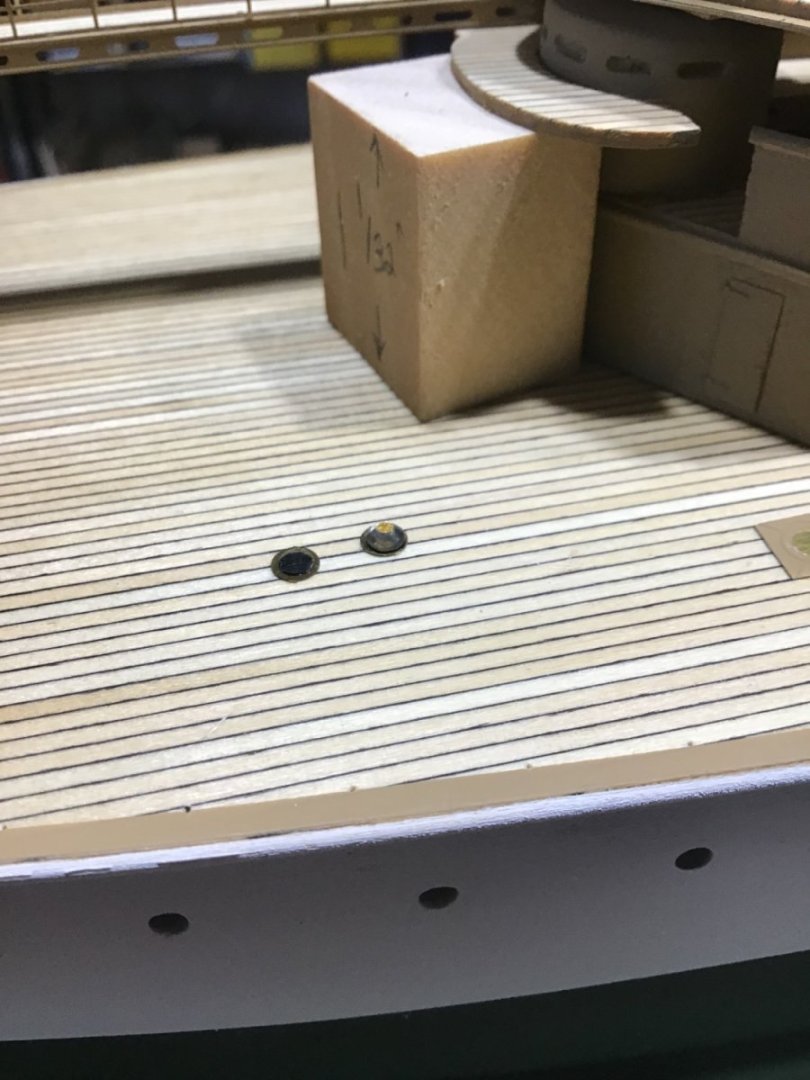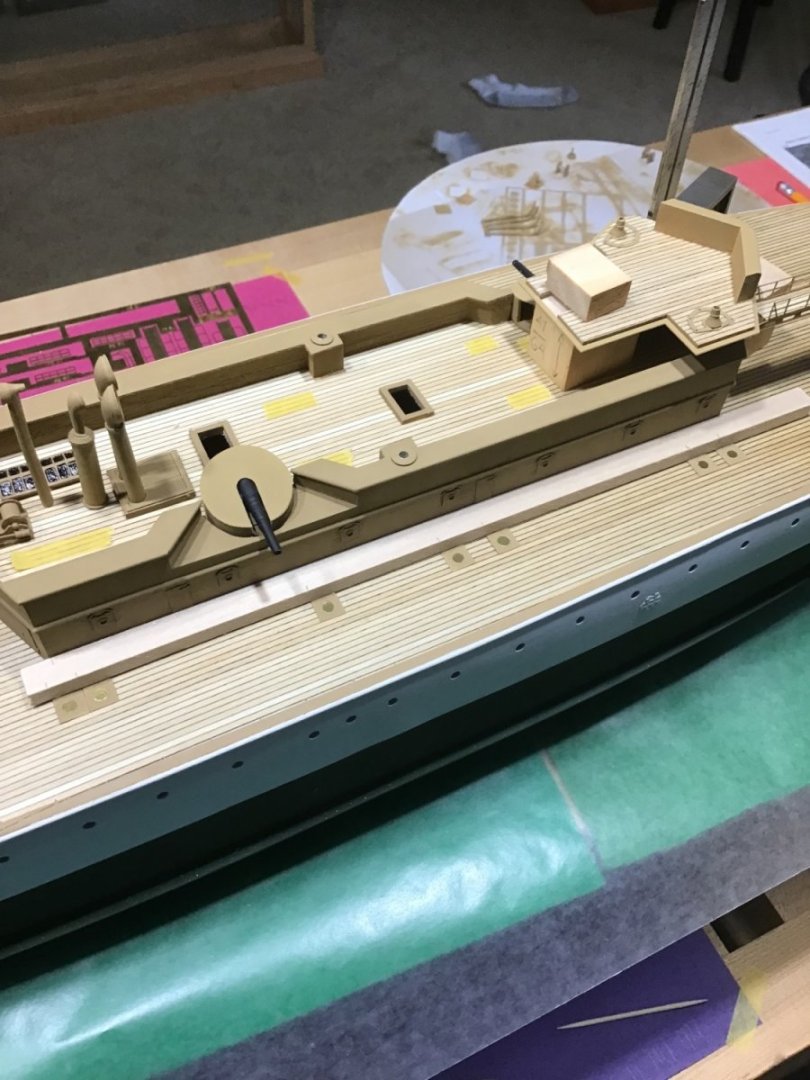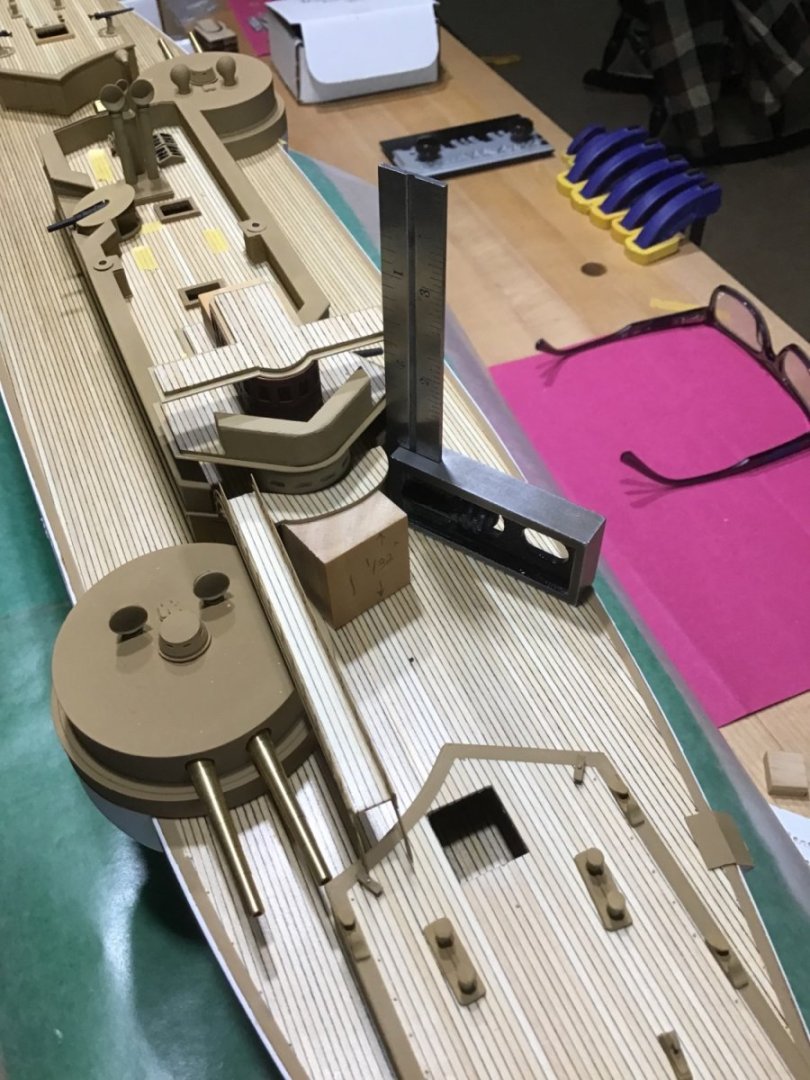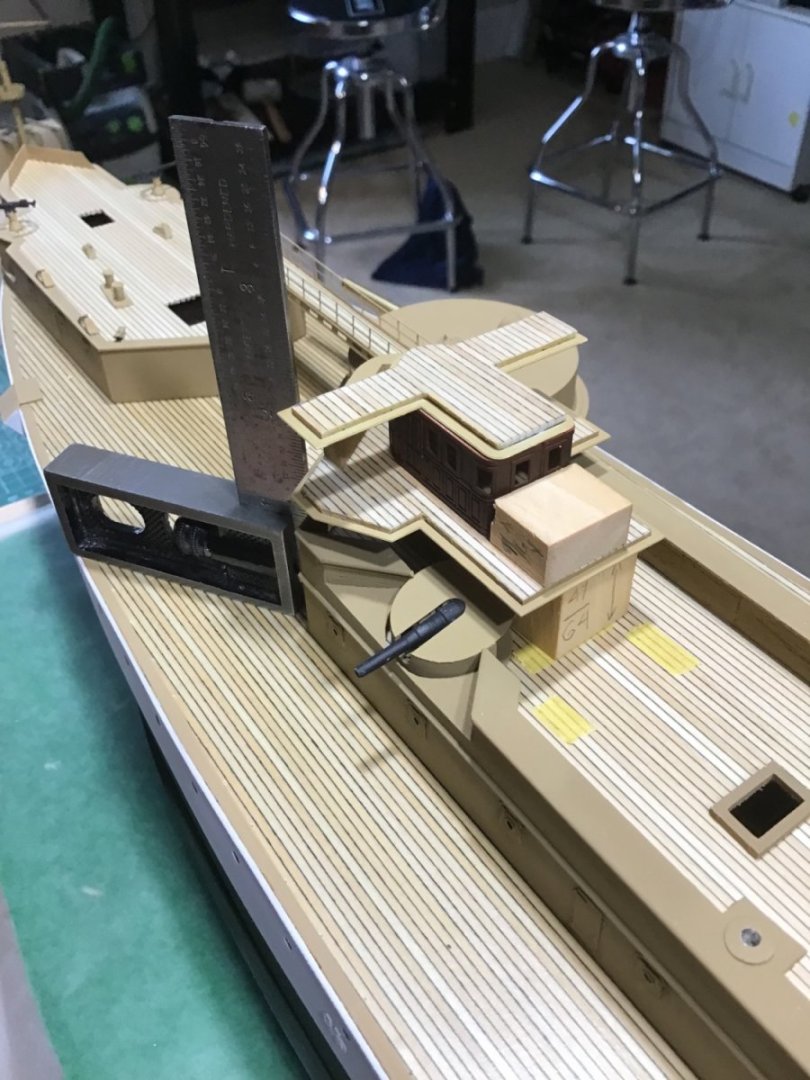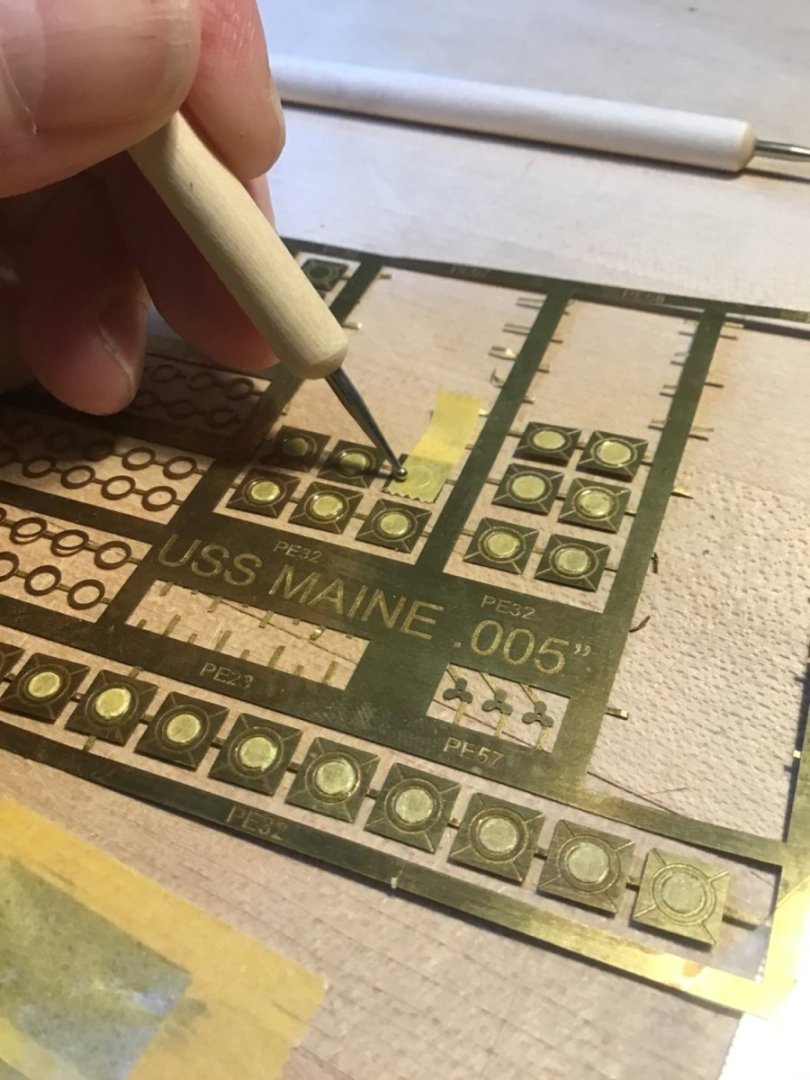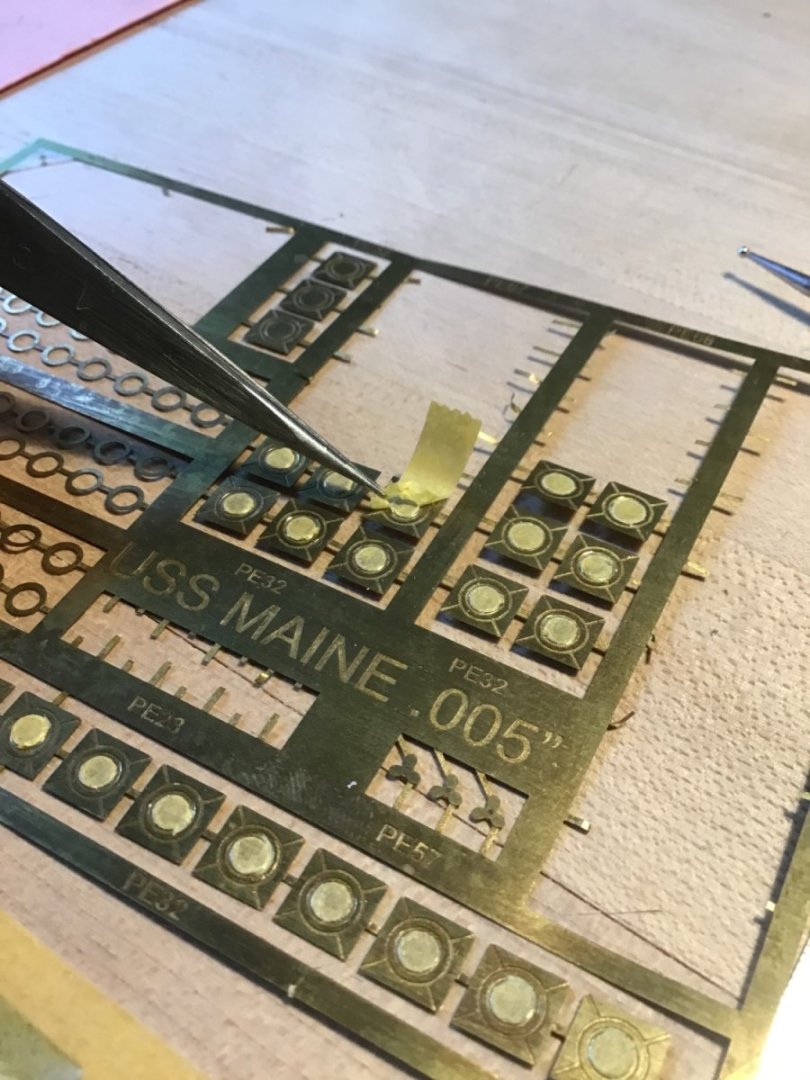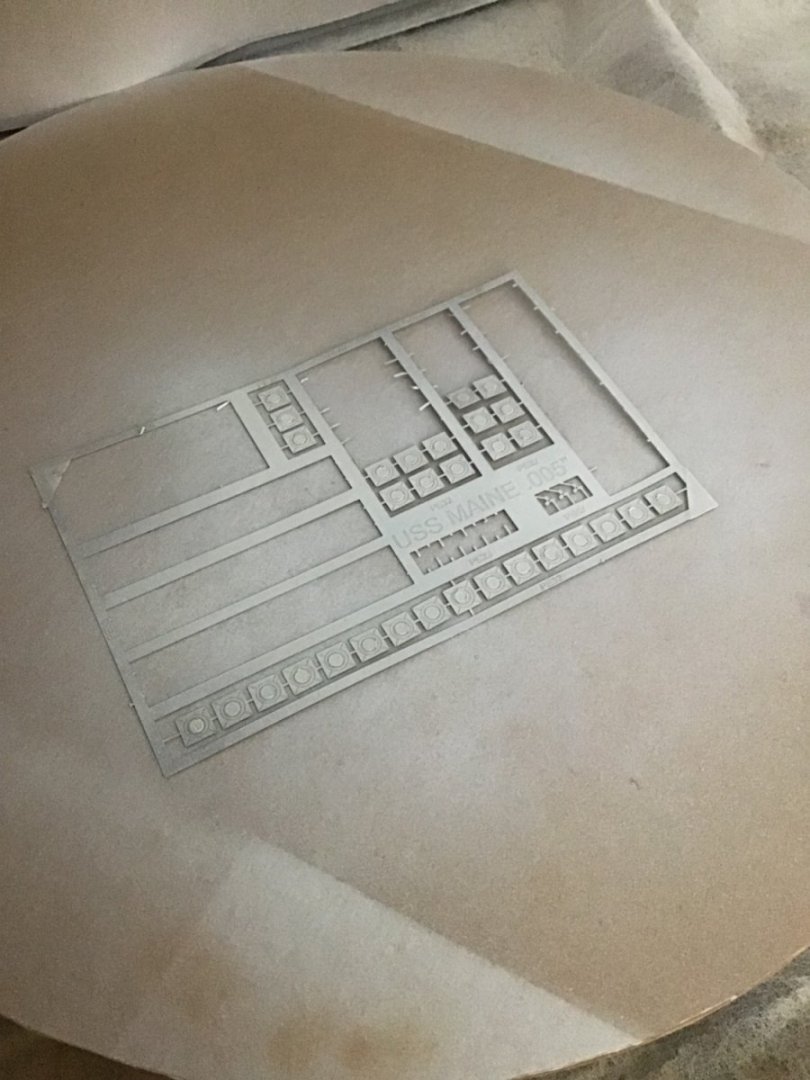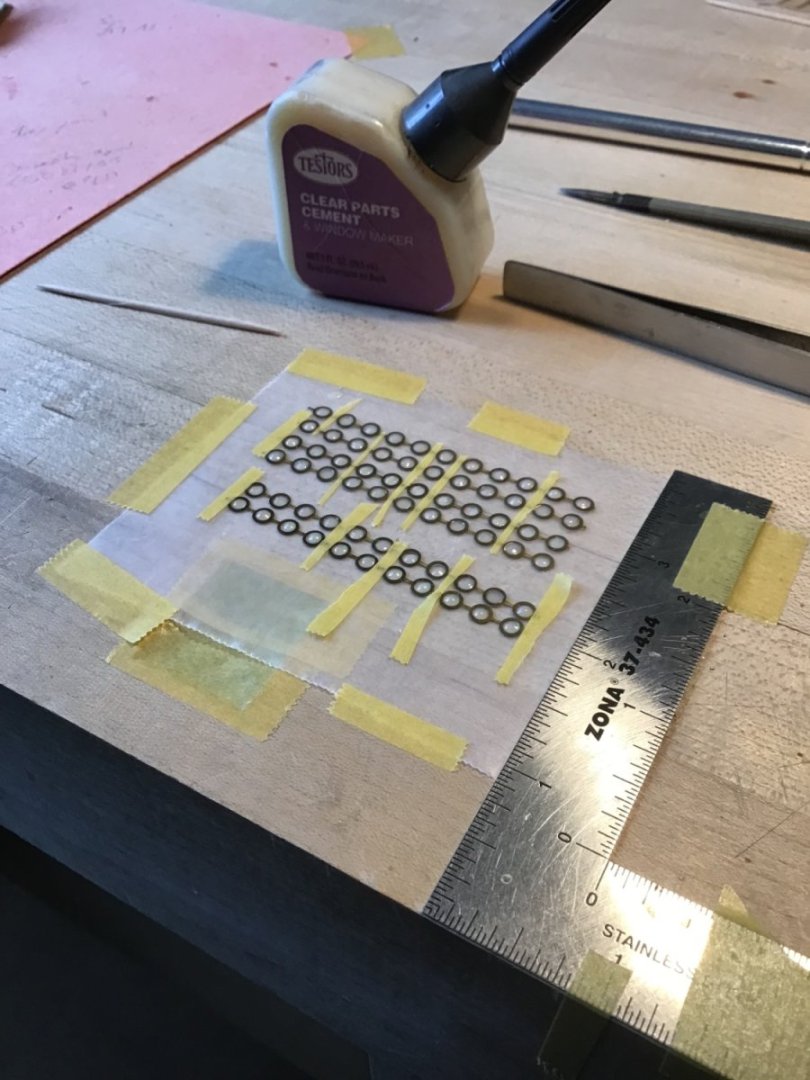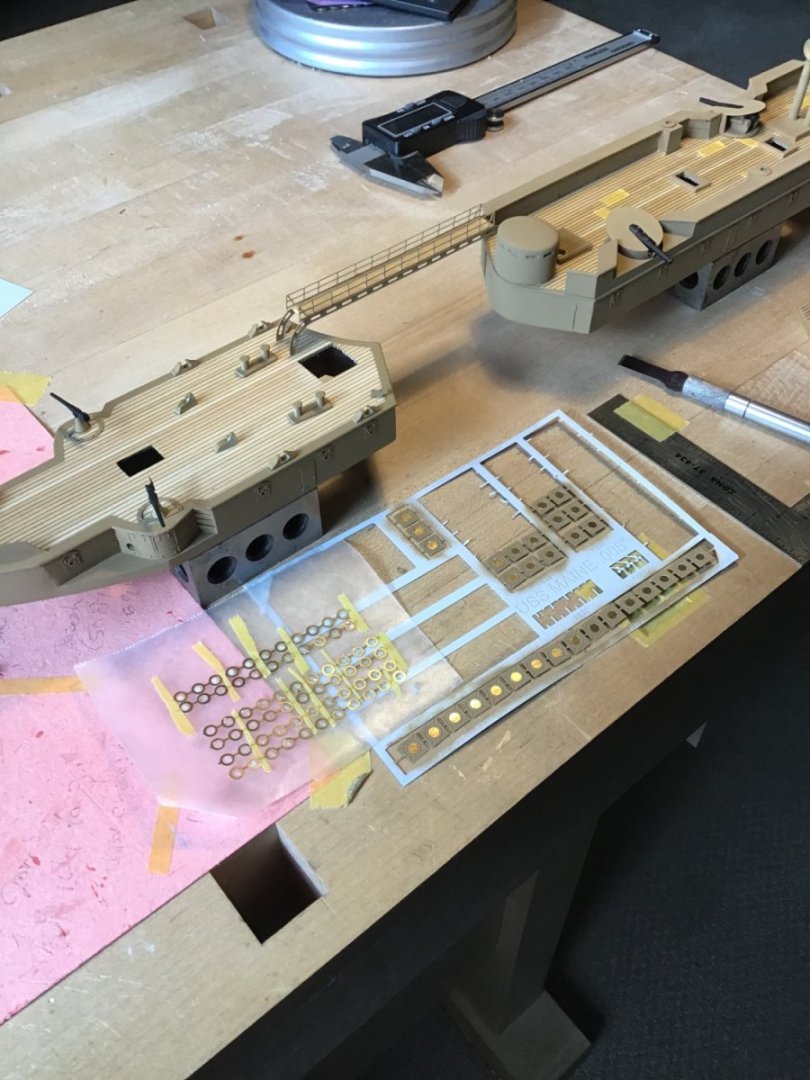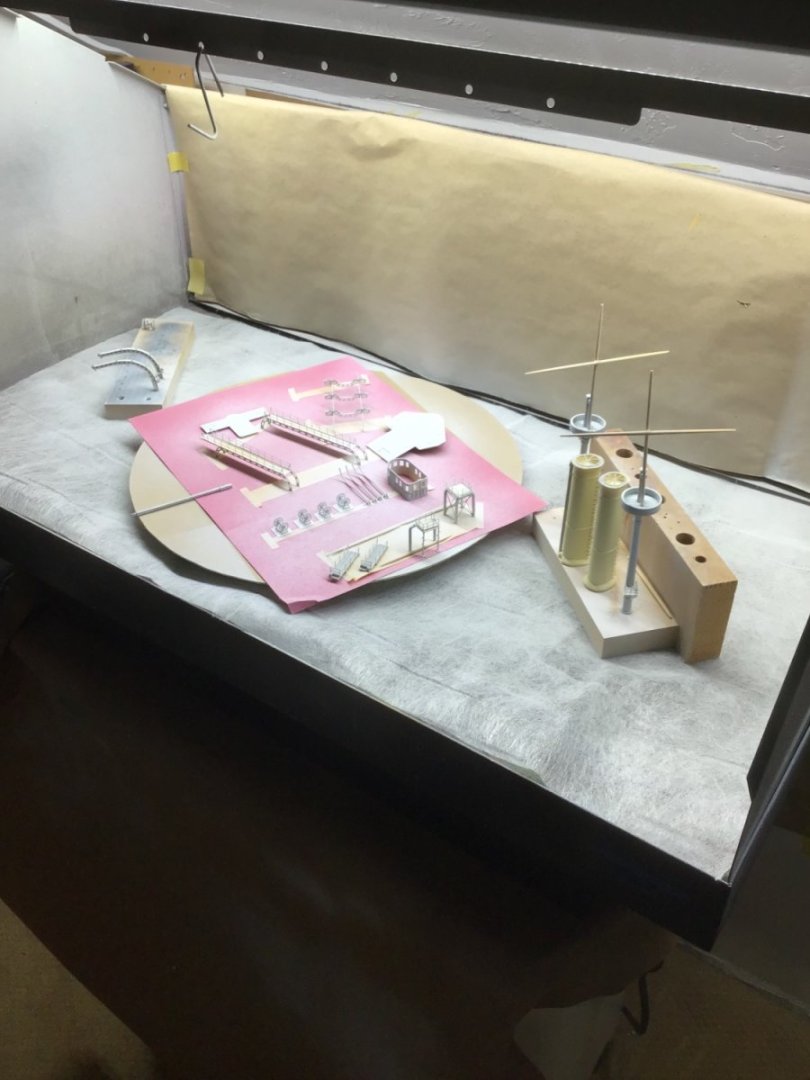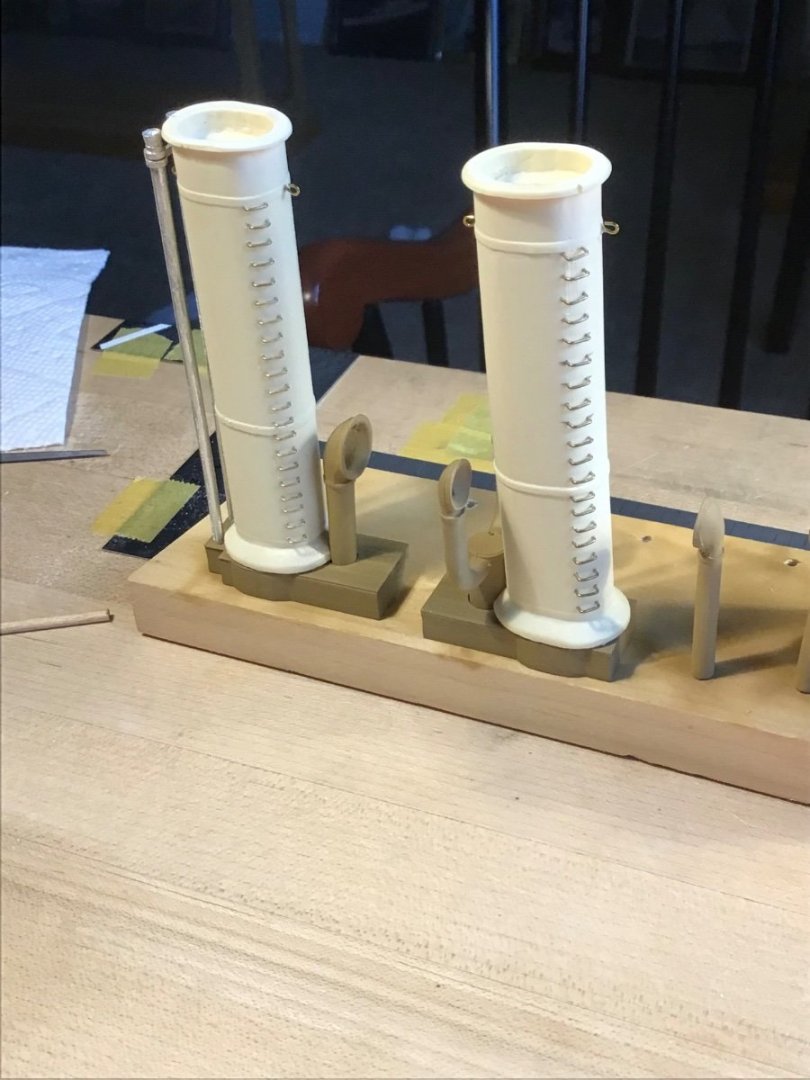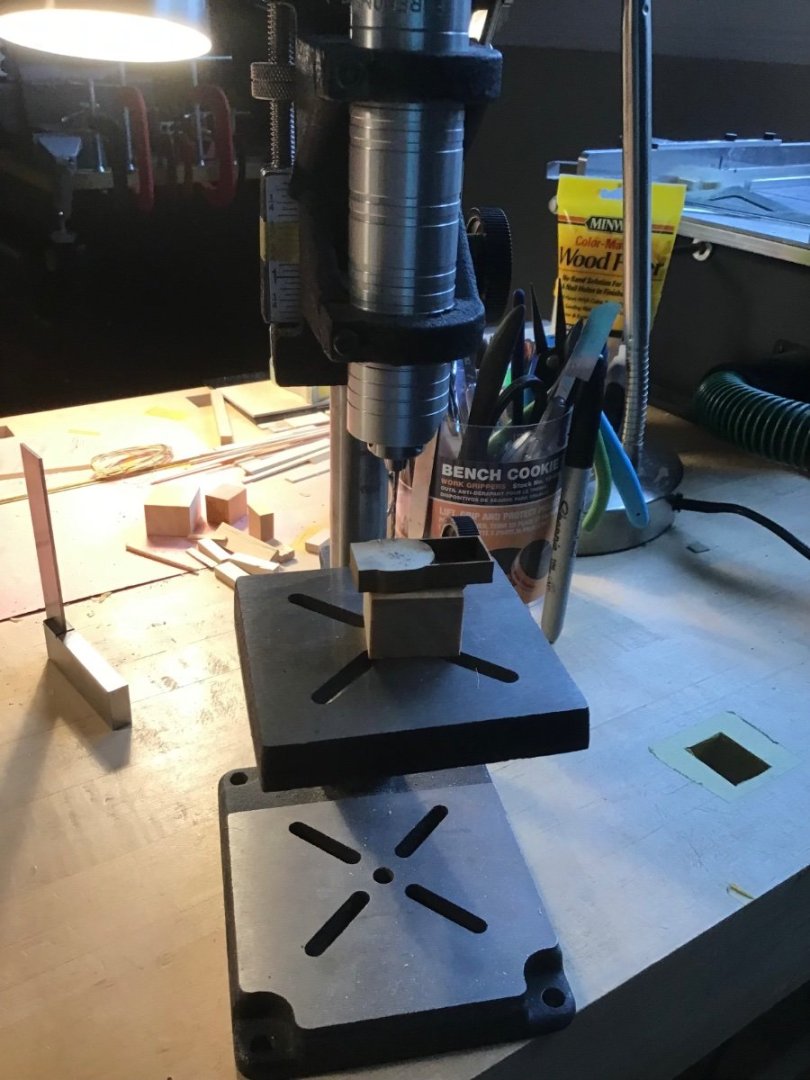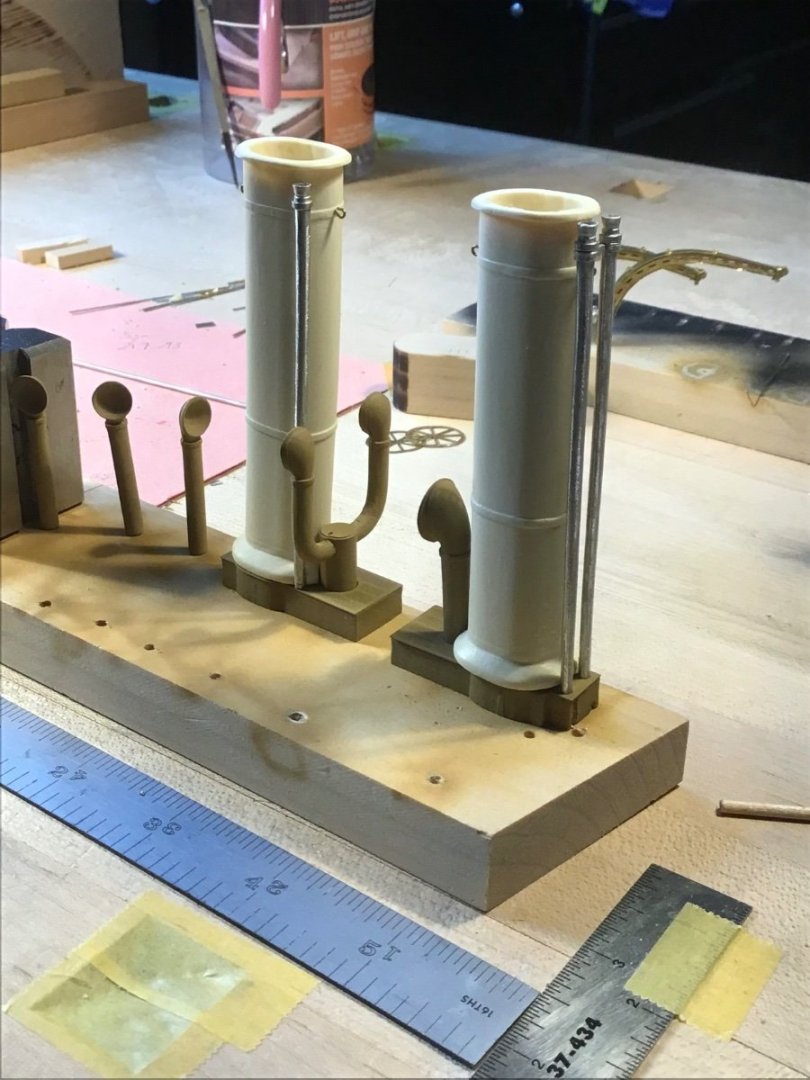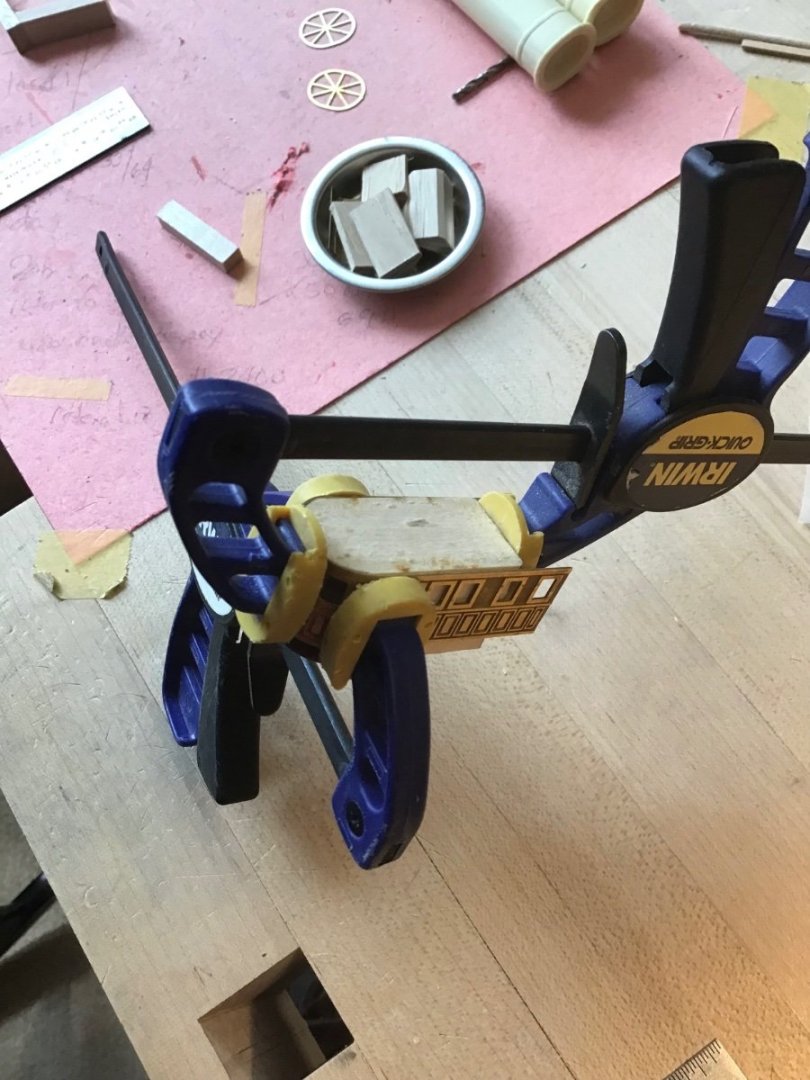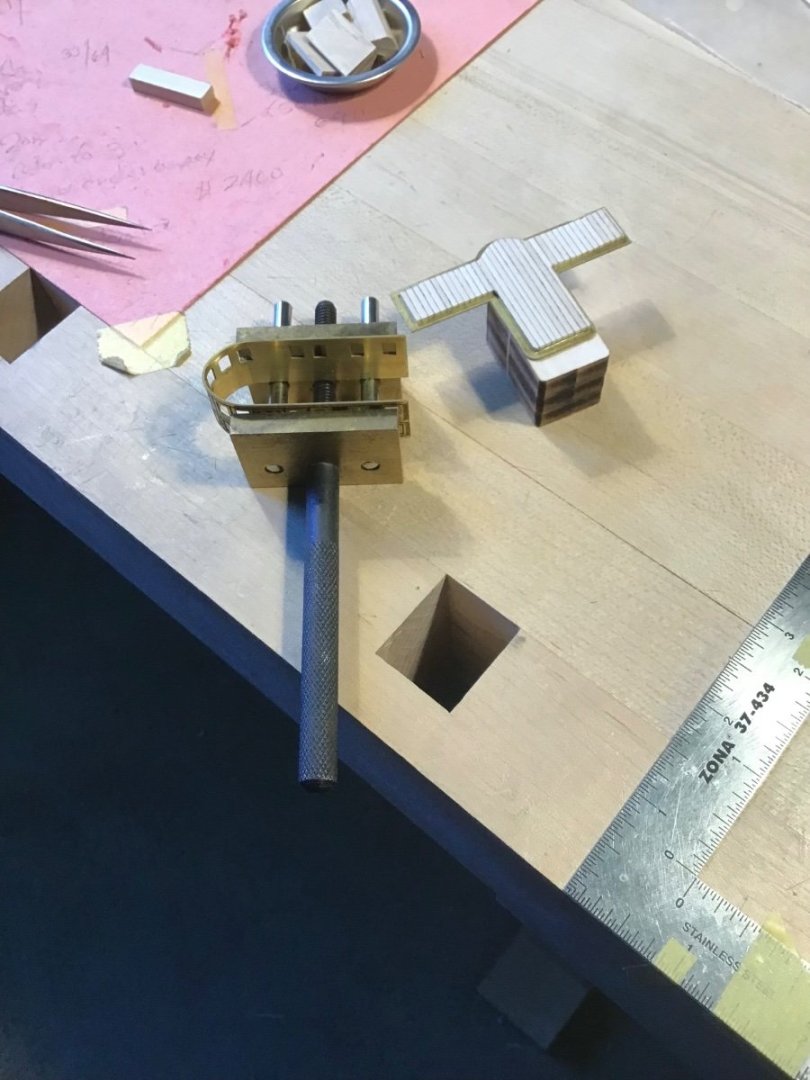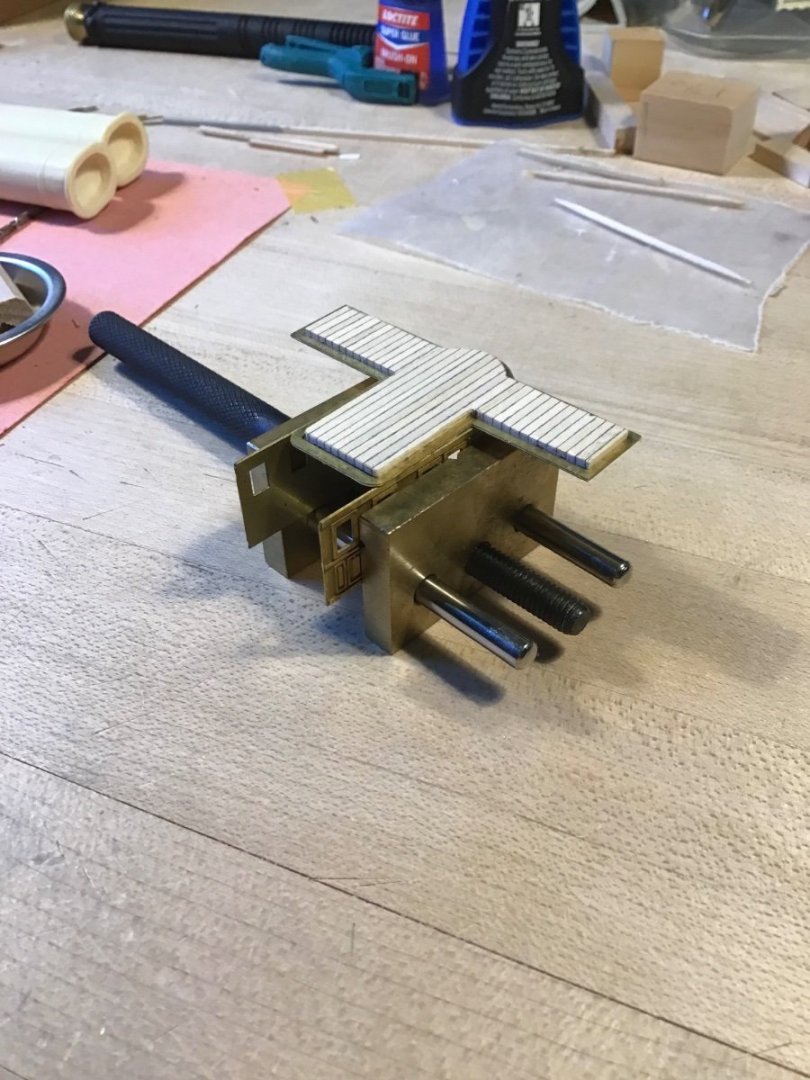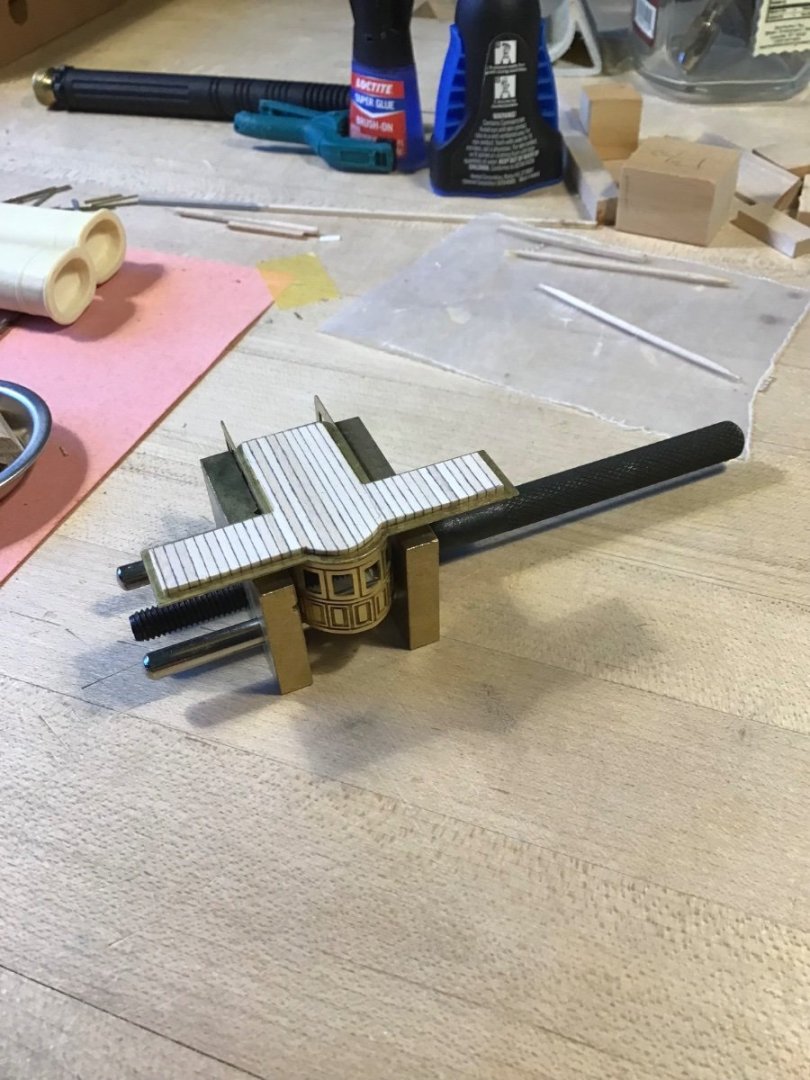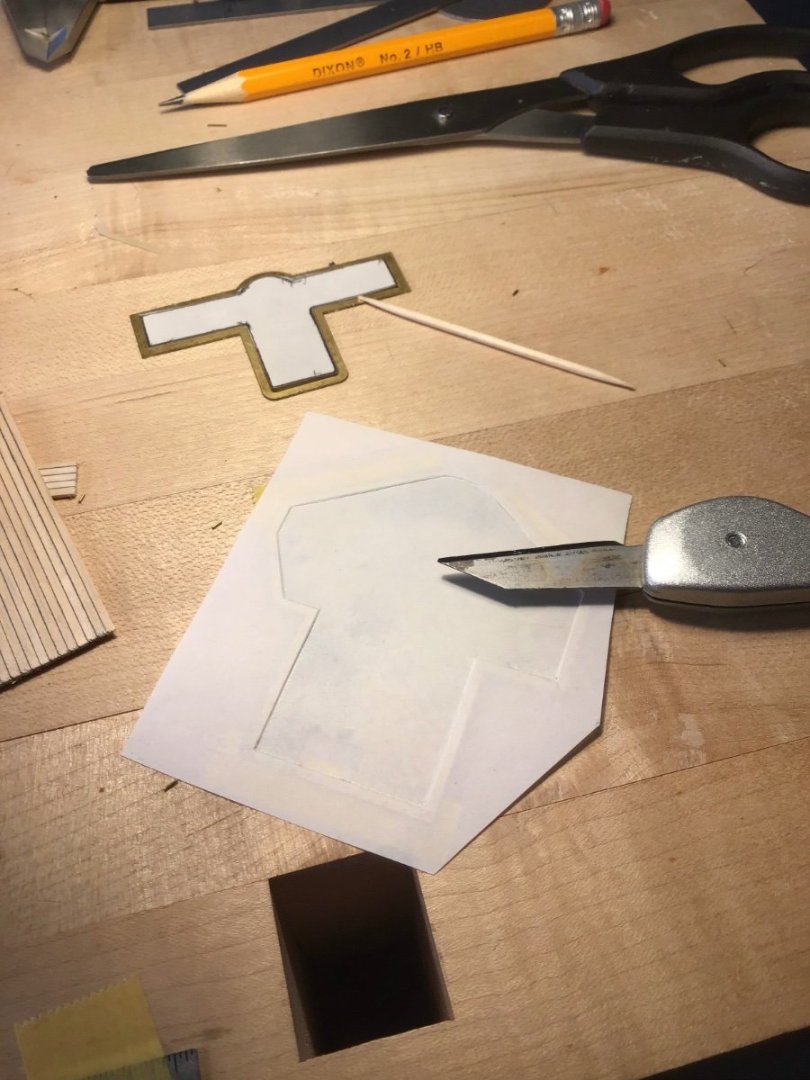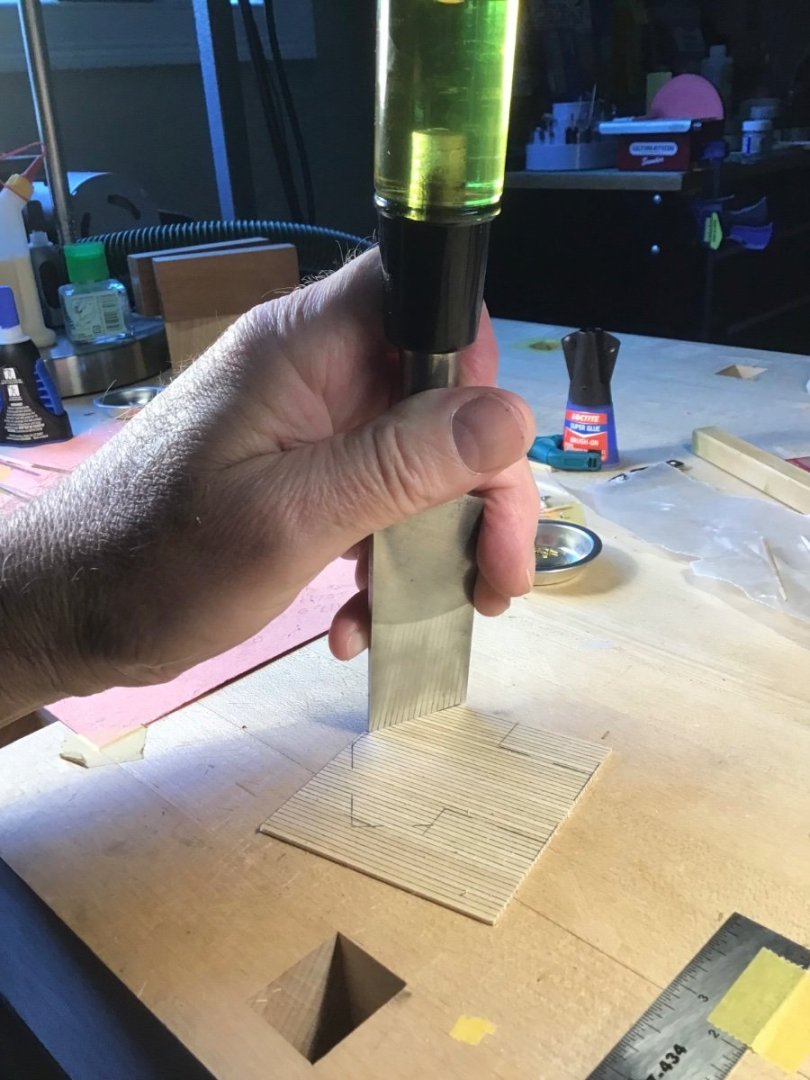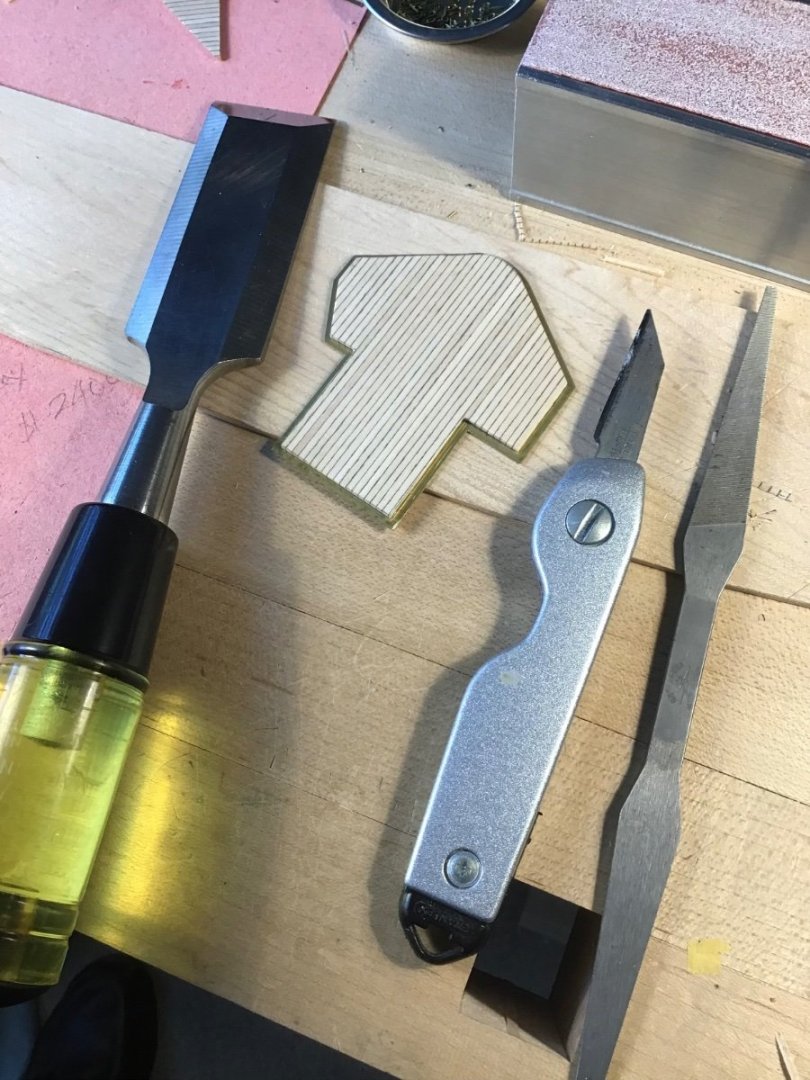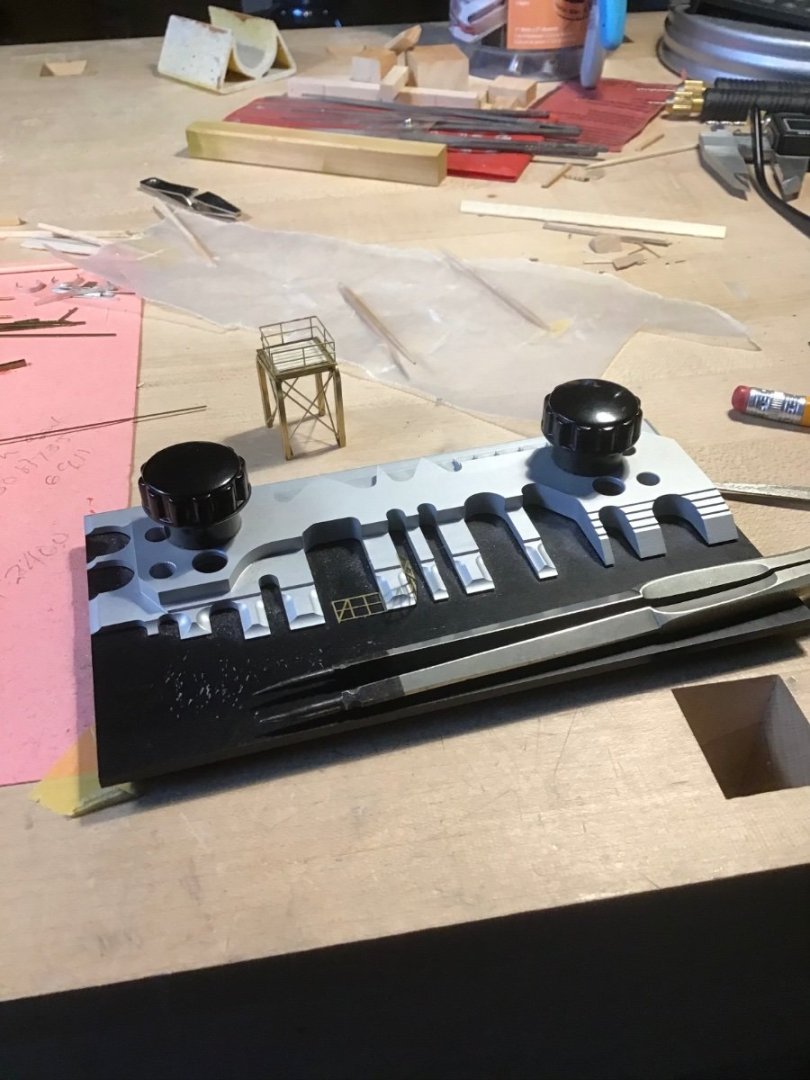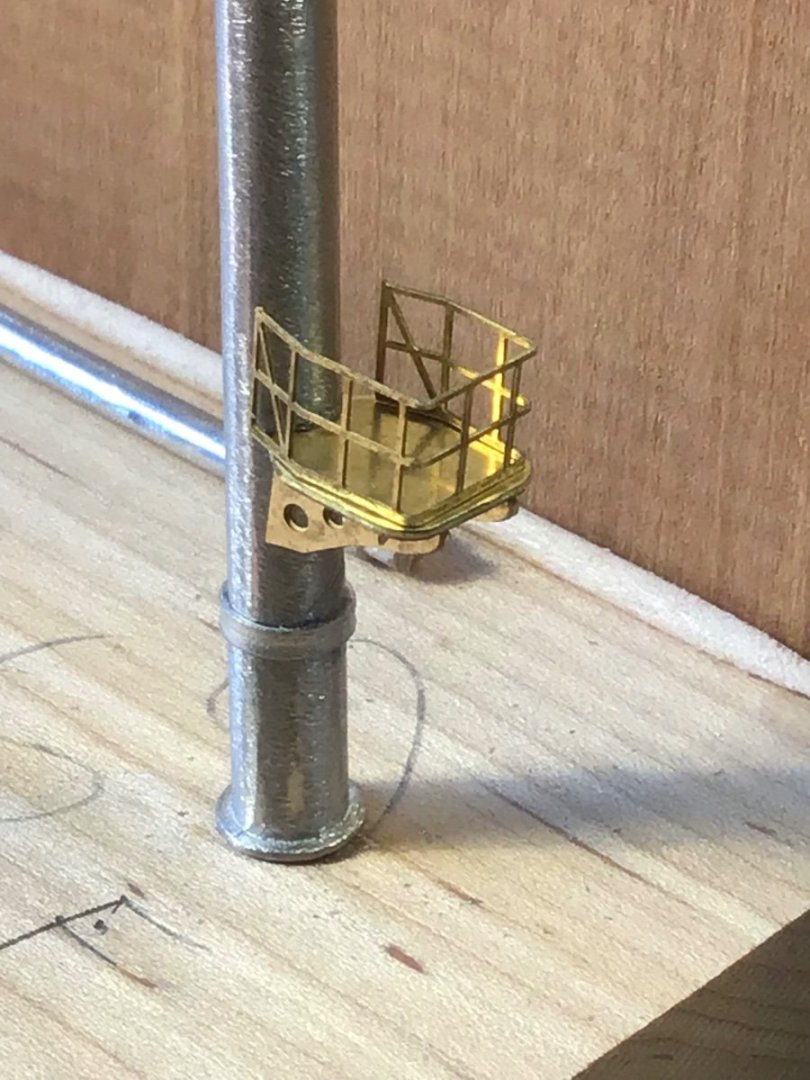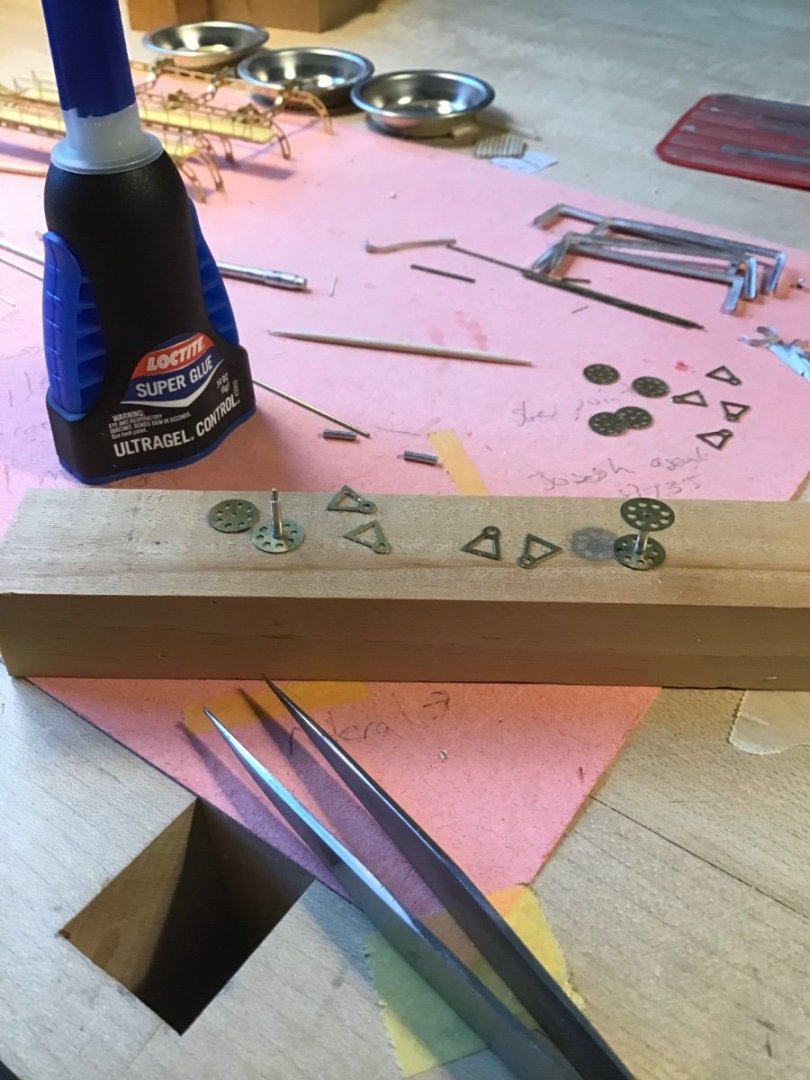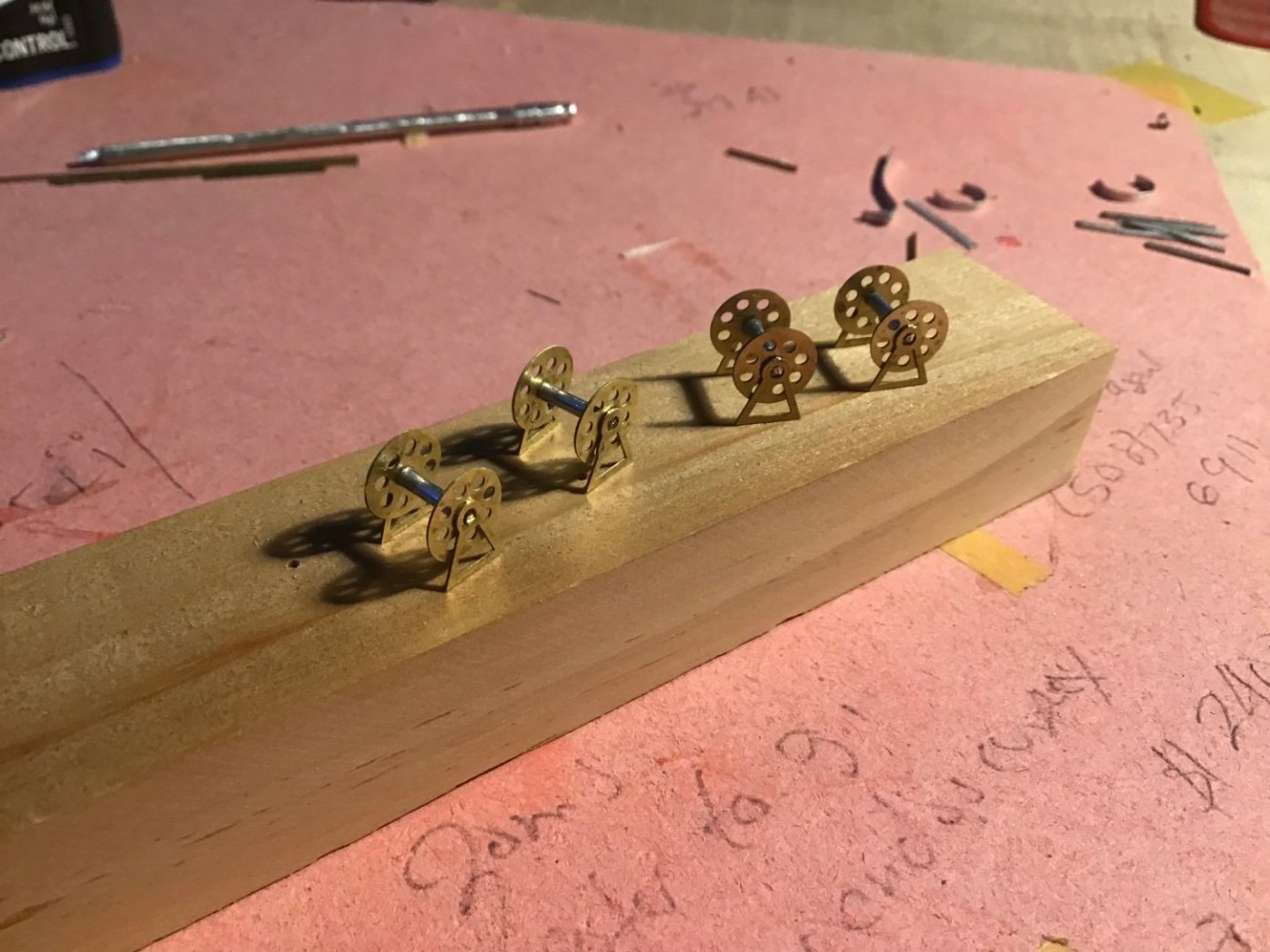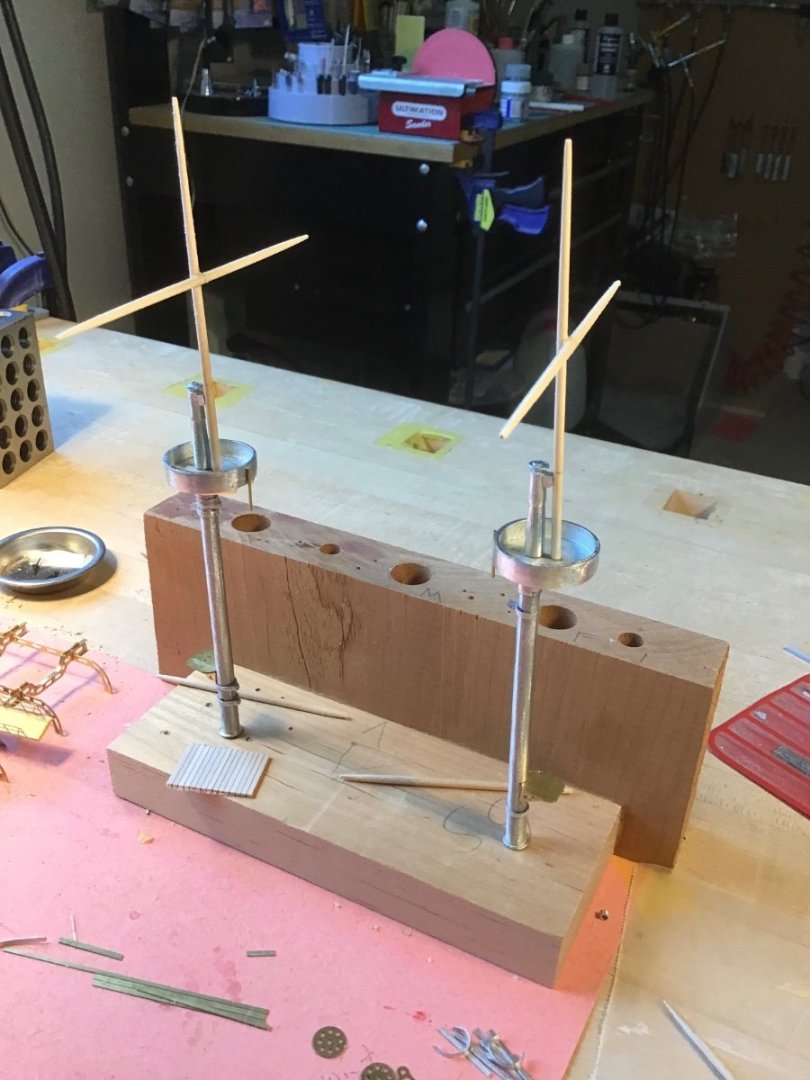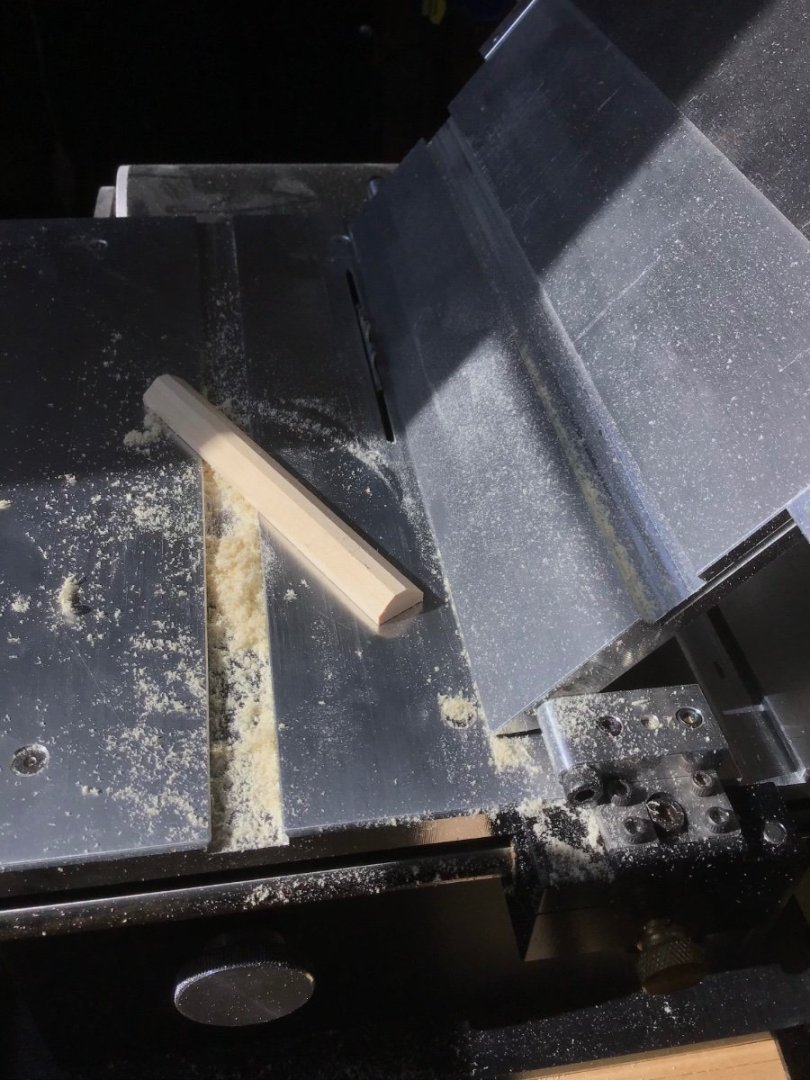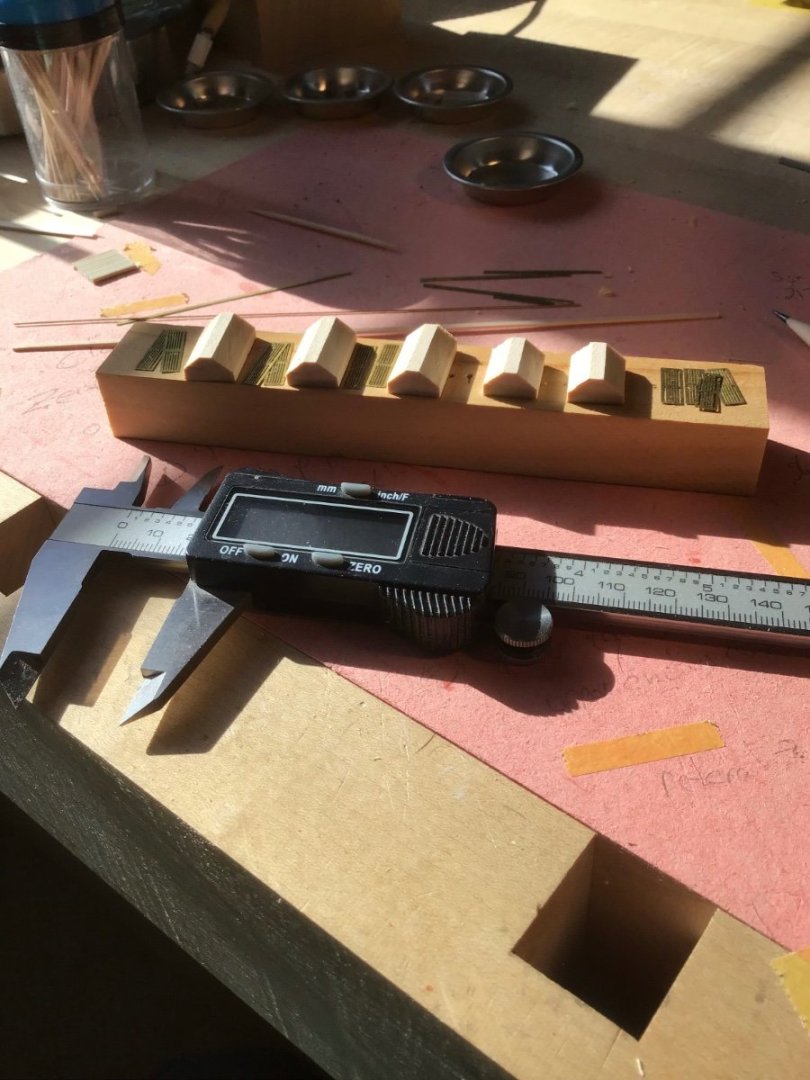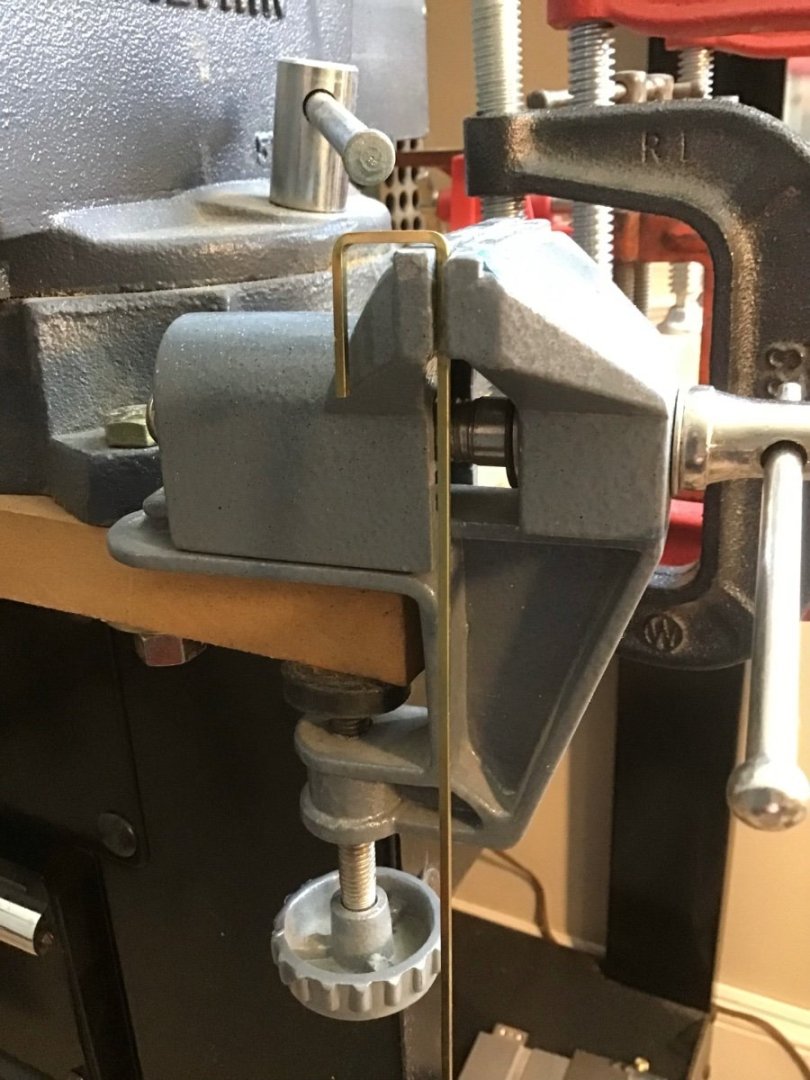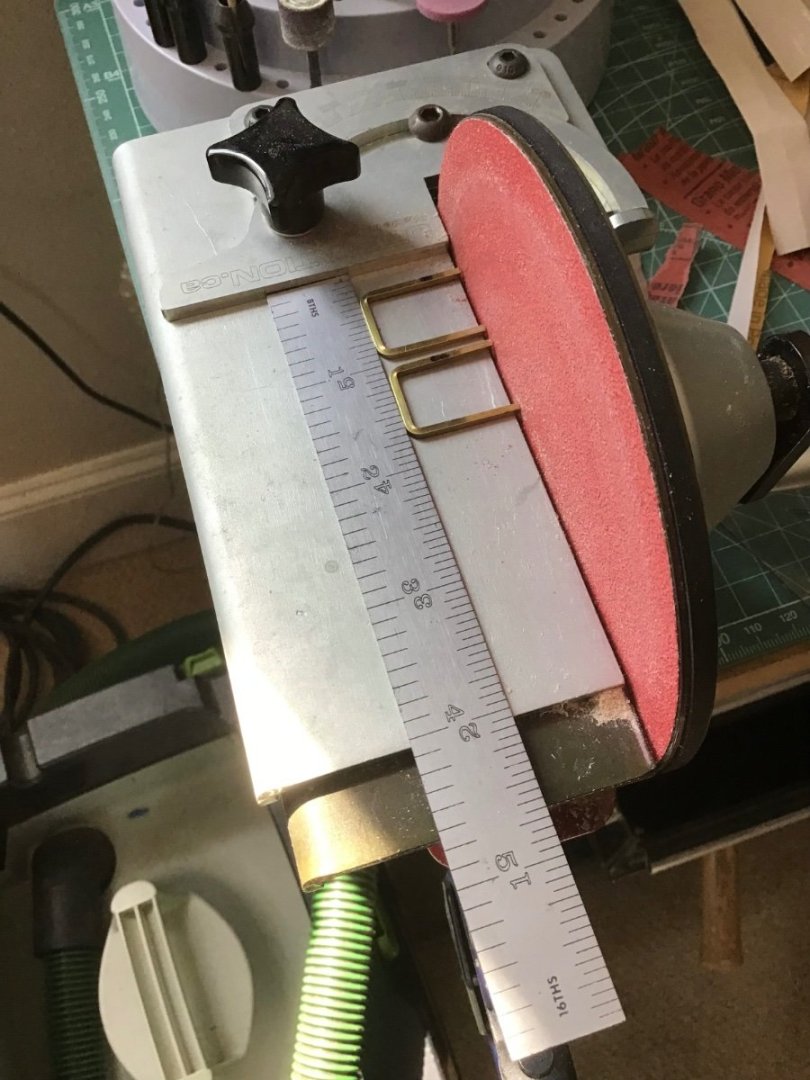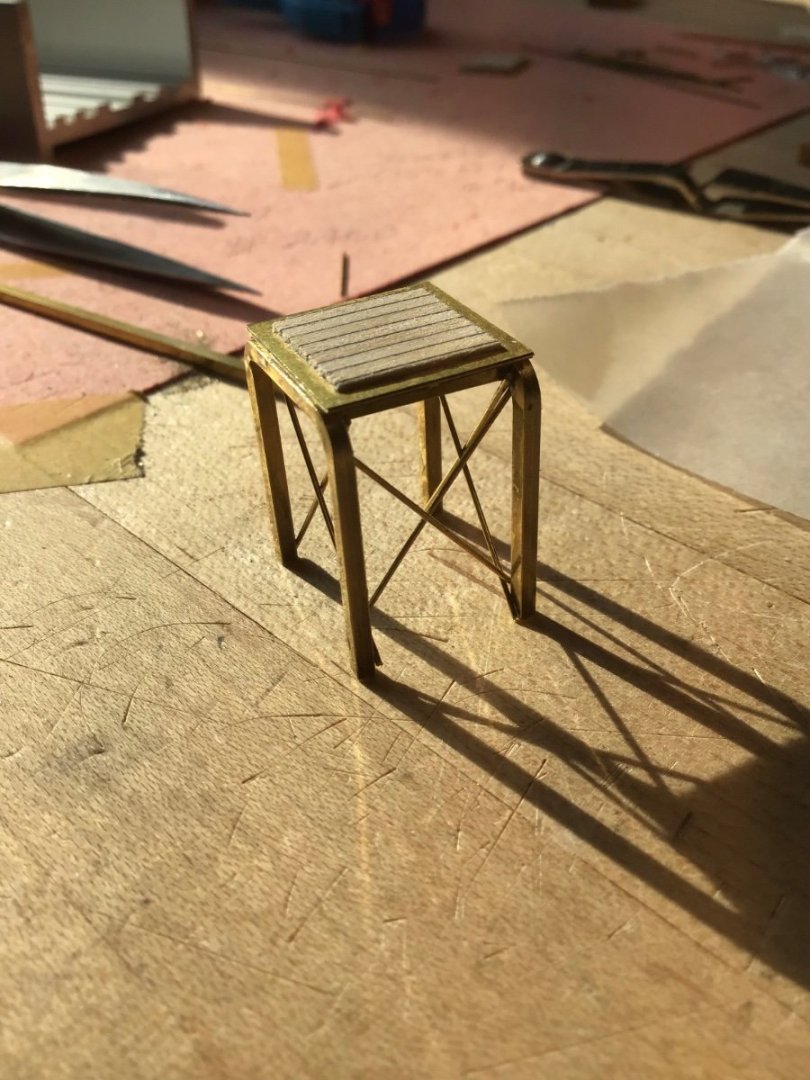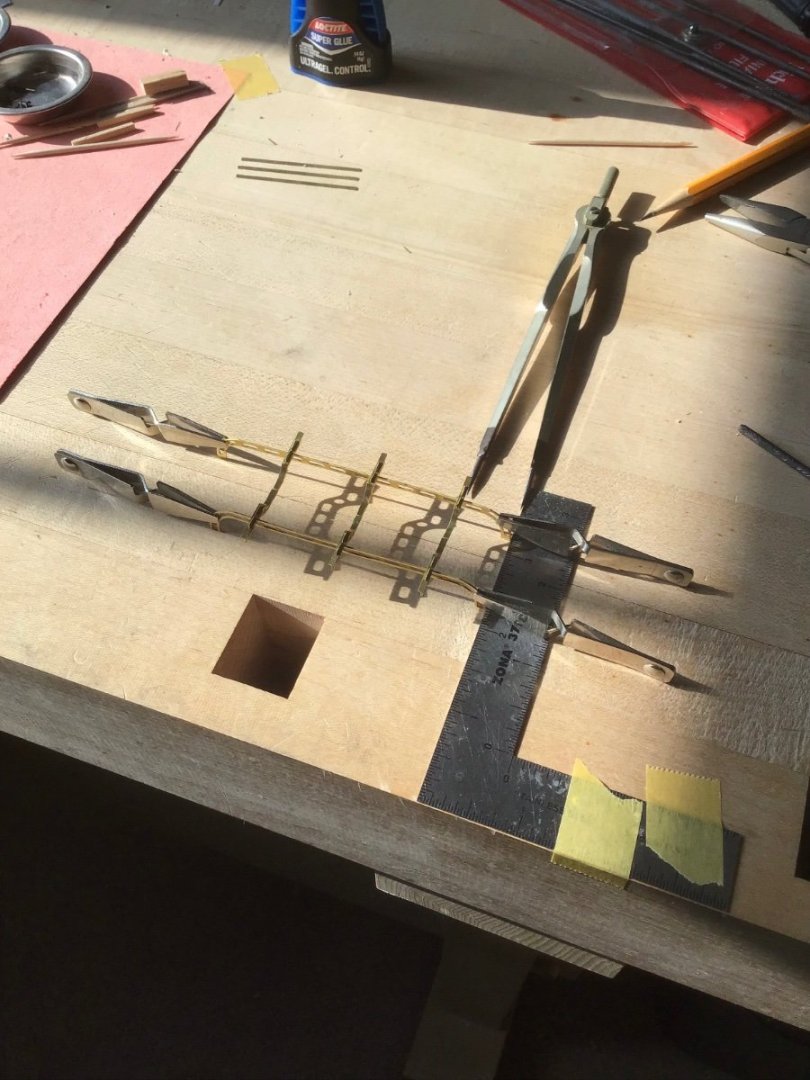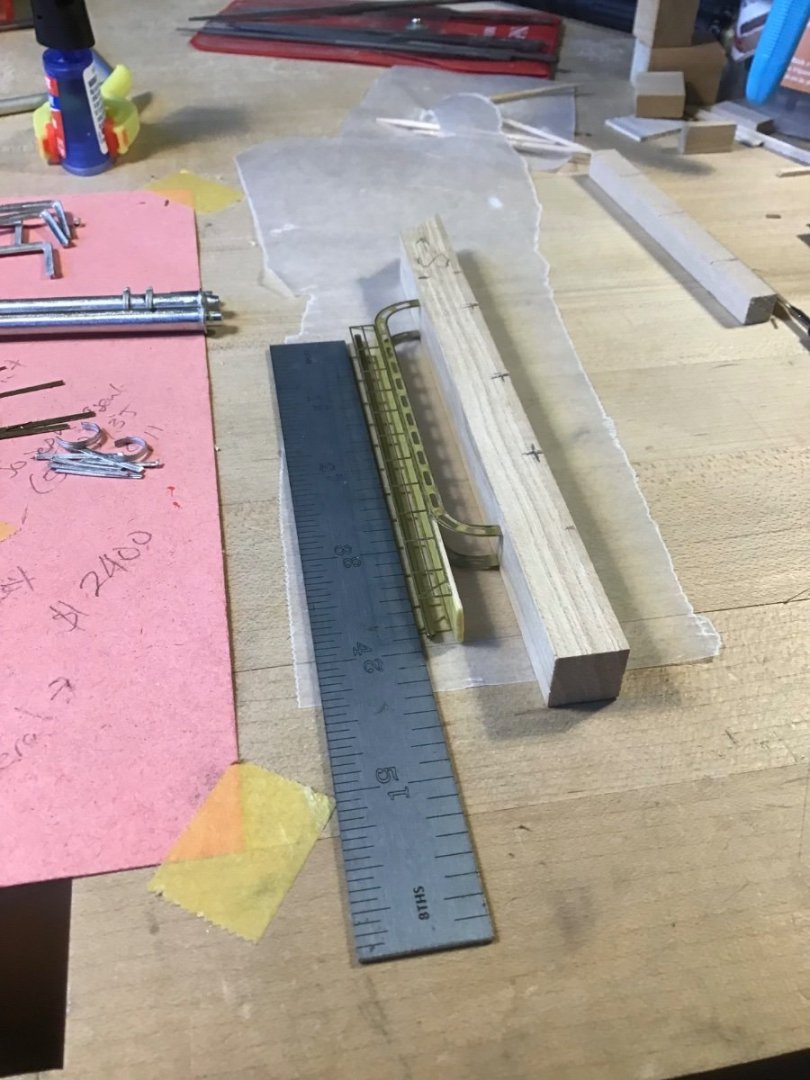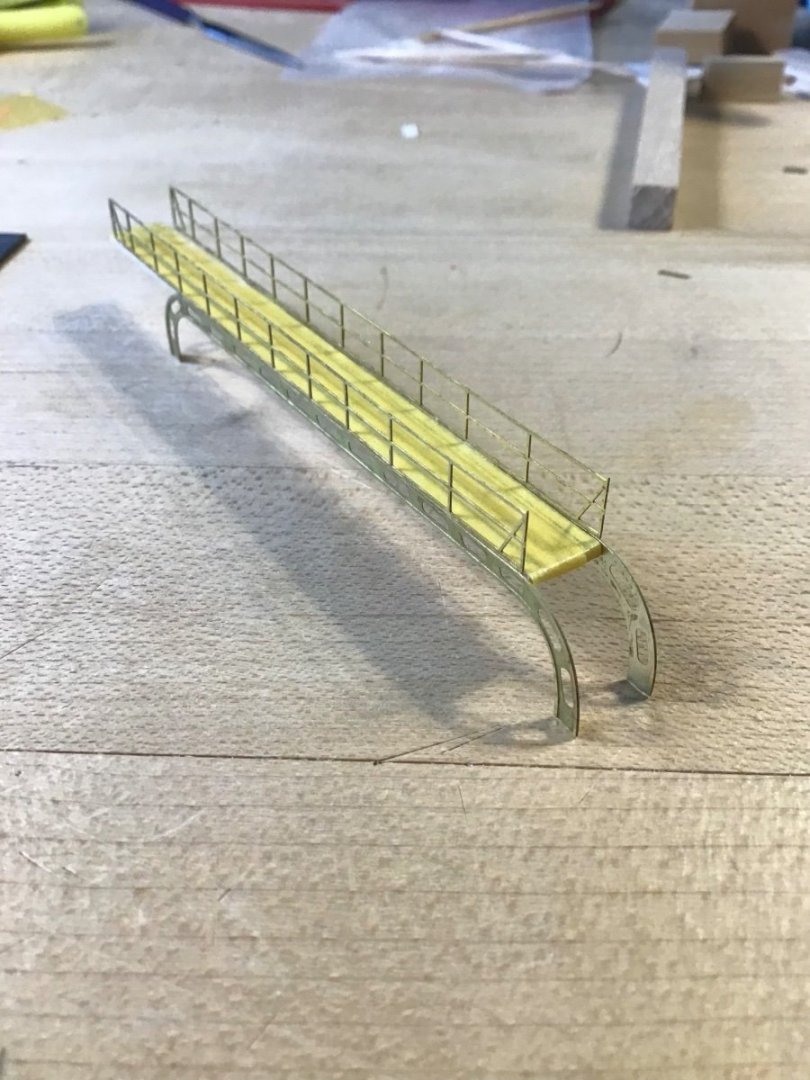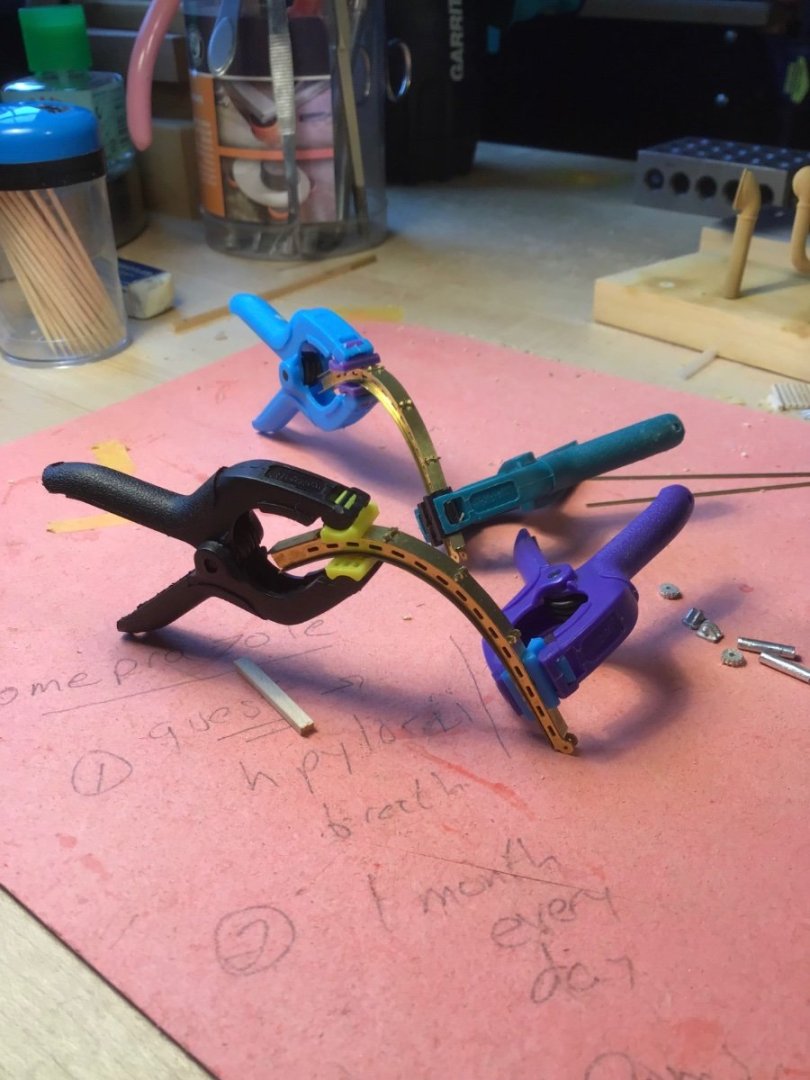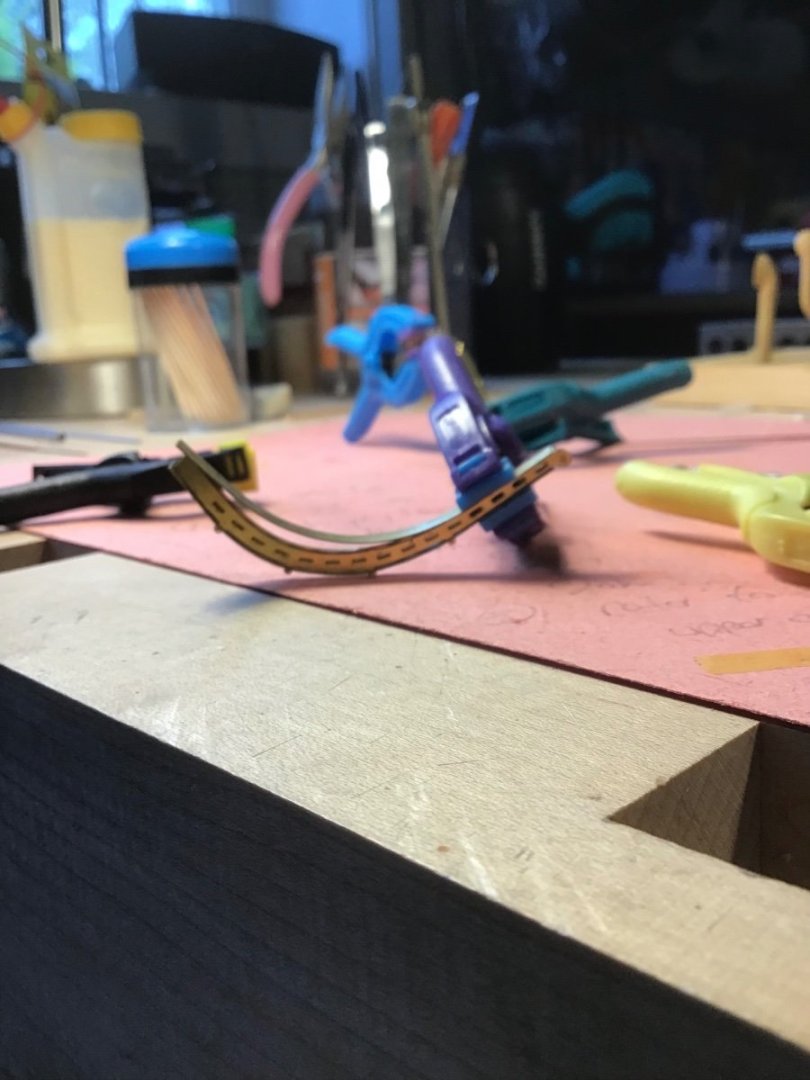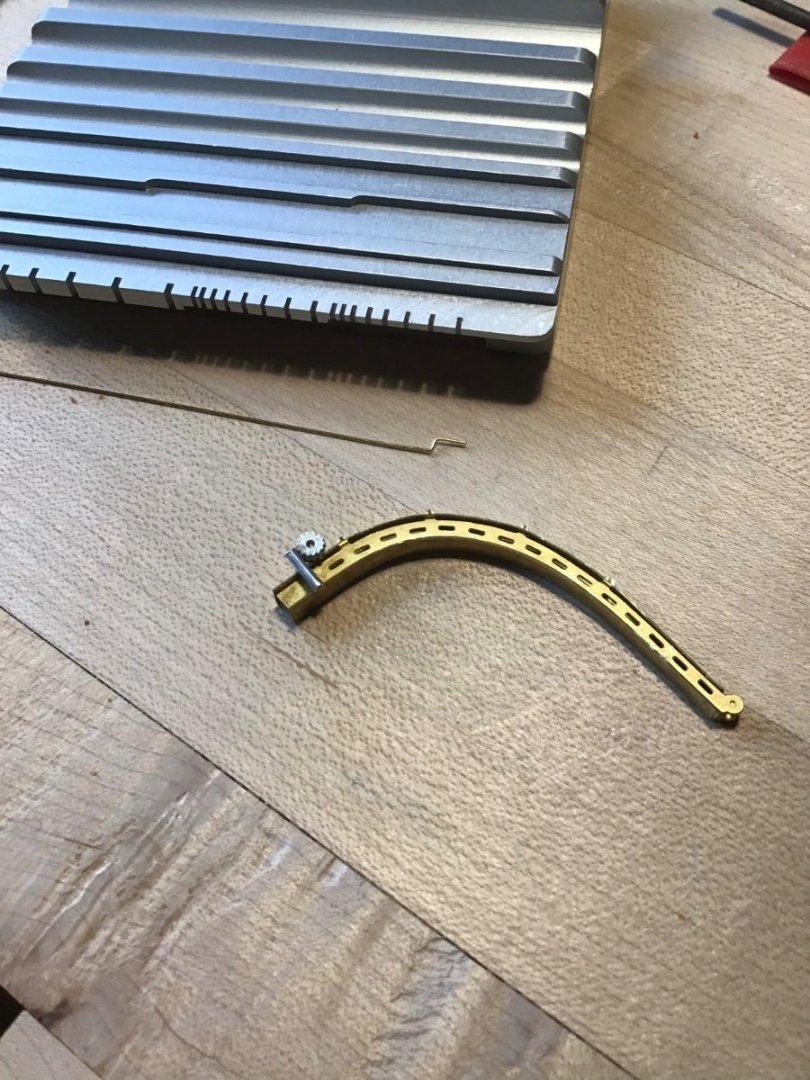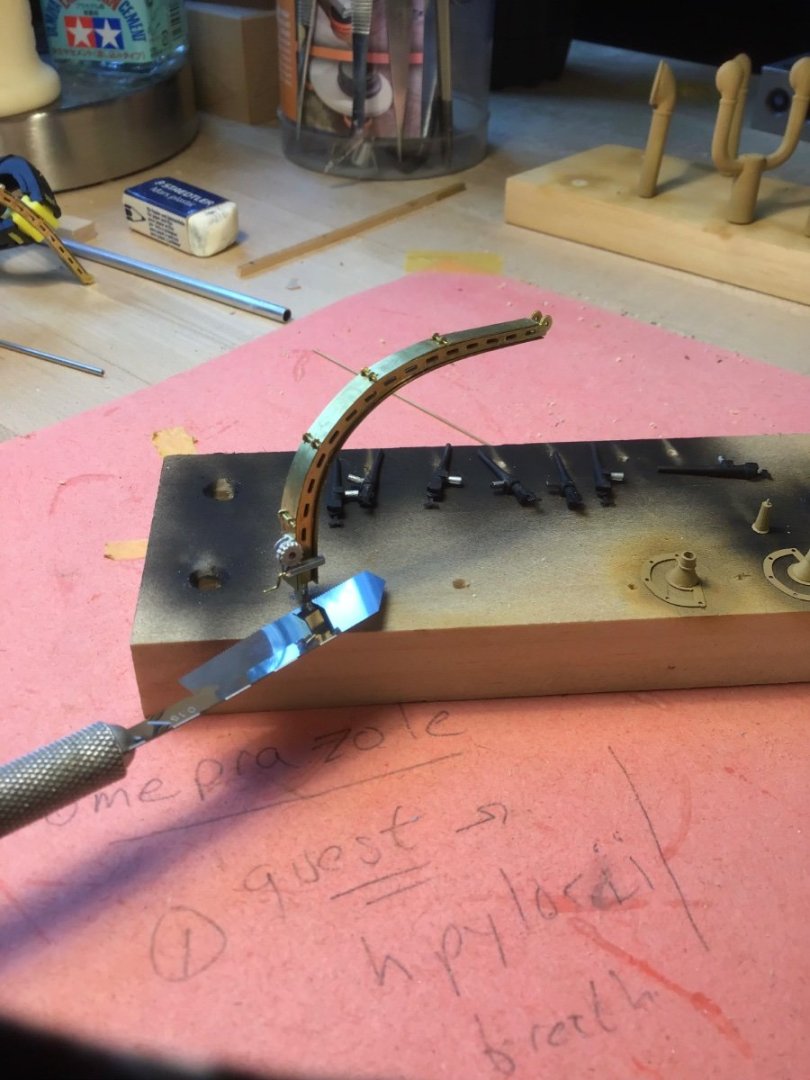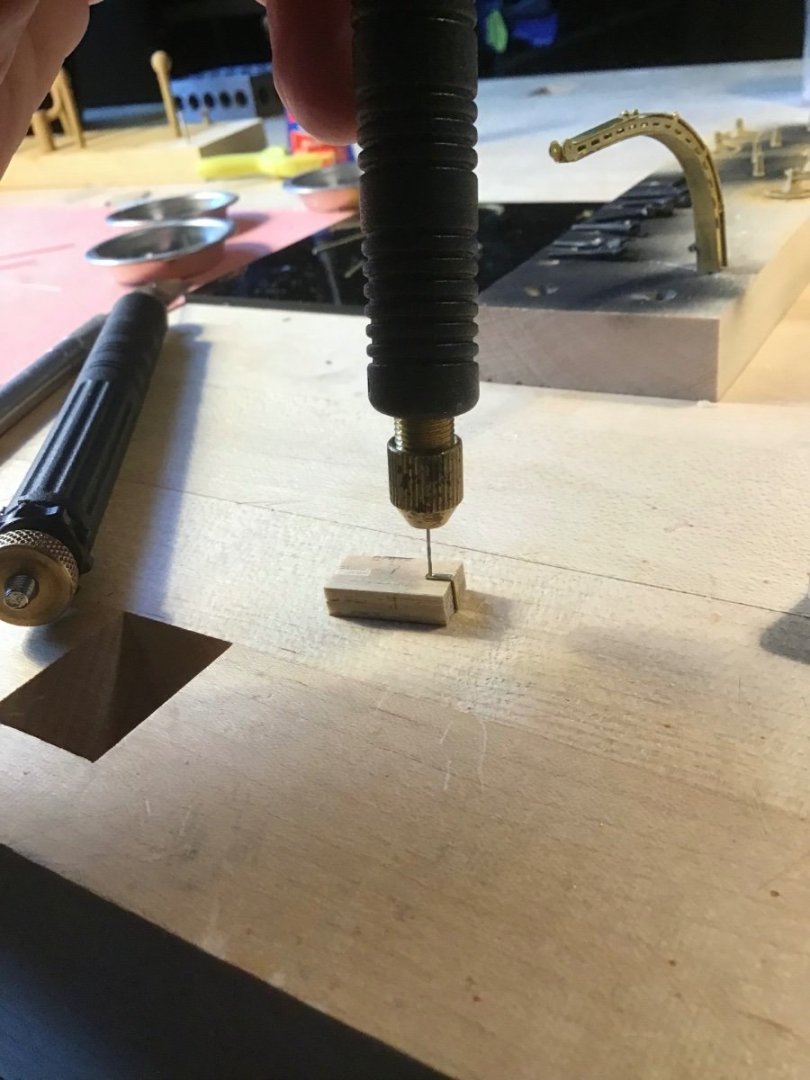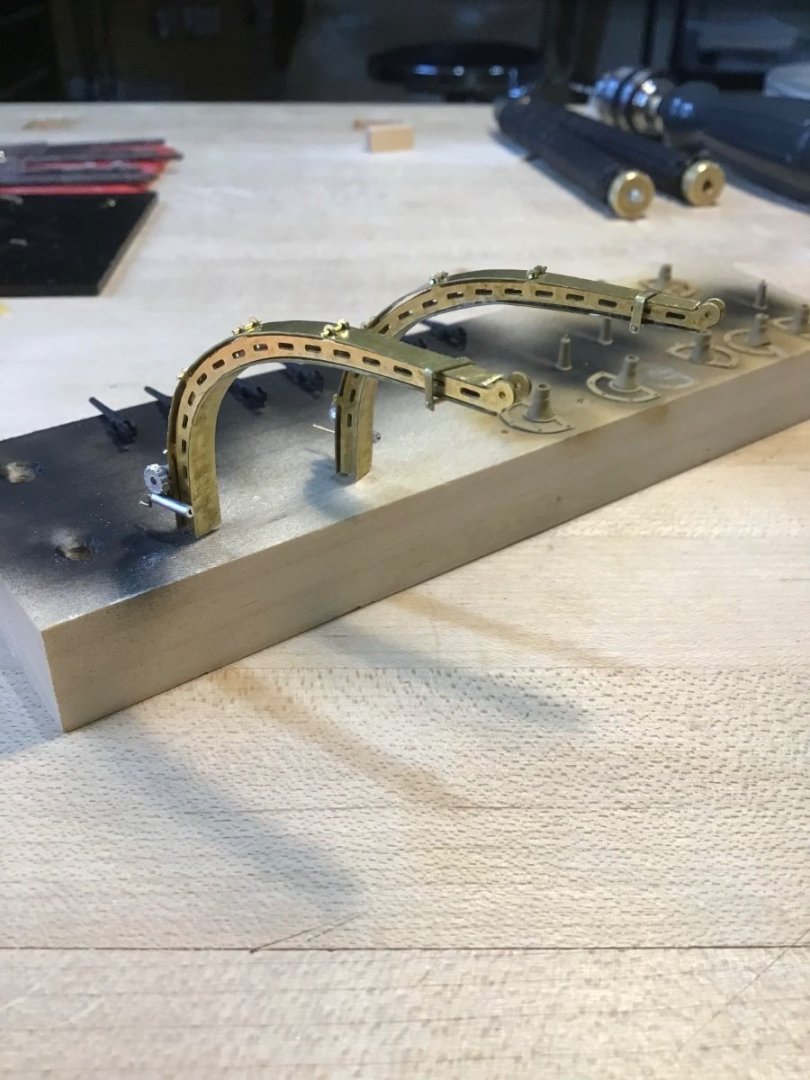-
Posts
733 -
Joined
-
Last visited
Content Type
Profiles
Forums
Gallery
Events
Everything posted by ERS Rich
-
Flying Bridge Supports Had to give this some thought as these supports need to fit exactly through square holes in the Navigation Bridge. Precise bends are required. The supports are 1/16” brass rod. Note my first attempt was not successful and needed more bar stock. Called Bluejacket and the crew helped and sent out additional stock right away for a reasonable charge. Decided to make a jig, shown below. The instructions call for 1/8” radius bends. So measured the inside spacing of the square holes in the Navigation Bridge, and drilled 1/8” holes in the board so the distance between the outside edges of the bits correspond to the measurement - 25/32”. Also installed a third bit, to minimize the upward bow, midway between the 1/8” bits. Make a mark on the piece to bisect it’s length, and register the mark on the middle bit, to help get even legs. I used the vise (available at Micromark) to make sure the bar as fully wrapped around the 1/8” bits. Dry fit…. Stacked up the superstructure to get an idea of the leg length. First pass, about a 1/16” gap between the pilot house roof and the flying bridge deck. Used wire cutters to take a nibble off the legs. Evened up the legs with the Ultimation disk sander and a file. Dry fit on the model….
- 166 replies
-
- Maine
- BlueJacket Shipcrafters
-
(and 1 more)
Tagged with:
-
Thank you Rick, tried to gear the information to show that ship modeling is doable. Cheers!
- 166 replies
-
- Maine
- BlueJacket Shipcrafters
-
(and 1 more)
Tagged with:
-
Progress Photos Almost in the home stretch. Navigation and Flying Bridge assembly are major bits left….
- 166 replies
-
- Maine
- BlueJacket Shipcrafters
-
(and 1 more)
Tagged with:
-
Forward and Conning Tower Catwalks It turns out I was too aggressive when flattening the conning tower. So during the dry fit found, rather than the two catwalks being flush, the catwalk deck was about 3/32” higher than the conning tower catwalk. I was able to reduce, but not eliminate the step, by making the grooves to accept the catwalk girders, as shown in the previous post deep. Here is the setup to check the dry fit. The long board in the catwalk is to square up the rail. And the block under the conning tower catwalk establishes the height, where the deck is 1/16” below the conning tower portals. It took many iterations of deepening the grooves, fitting the catwalks, and trimming the conning tower catwalk railing to get it nice. Blocks removed. Slight gap where the railings meet. Will try to close it up, but hardly noticeable and don’t want to snap off the catwalk railing, since that glue joint is hard to work with. Decided to use this brass bar to apply pressure to close the gap, then hit the joint with liquid CA.
- 166 replies
-
- Maine
- BlueJacket Shipcrafters
-
(and 1 more)
Tagged with:
-
Hi Jacques, Your boat looks nice. A couple of ideas to consider. It is all about the finish. Wood fibers, in particular pine, because of sap, absorb paint differently across the board grain. So unprimed wood can appear blotchy, again pine in particular. There are products to “pretreat” pine prior to finishing, meant to even out the finish. However, blotching or uneven finish absorption, may not be a bad thing, depending what you are going for. This is a wood kit, if the wood is say completely primed and painted so evidence of wood disappears, the finished product can look plastic. On the other hand, evidence of wood, meaning the grain is visible, tells the observer they are looking at wood. I like both of the pictures above, the first looks like a boat that’s been in service a while, the second looks like the boat is new. Thanks
- 62 replies
-
- First Build
- Grand Banks Dory
-
(and 2 more)
Tagged with:
-
Checkout Tamiya masking tape…. Cheers
- 62 replies
-
- First Build
- Grand Banks Dory
-
(and 2 more)
Tagged with:
-
Installing the Catwalks Inevitably both catwalk legs are not entirely level, fore and aft, and side to side, and the deck is slightly uneven as well, so need to level the assembly on the deck. This assembly is fragile to say the least. Decided to tackle the problem by making a groove in the deck and recessing the legs. Practiced with a couple of pieces of scrap deck. First made a dimple in the deck on the outboard side of each leg. Then set the dividers to the leg width and made a second dimple. Then drilled out the dimples with a 1/64” bit, drilled several other holes in between and cleaned out the waste. Nice fit!
- 166 replies
-
- Maine
- BlueJacket Shipcrafters
-
(and 1 more)
Tagged with:
-
Thanks a lot Rick, appreciate the encouragement.
- 166 replies
-
- Maine
- BlueJacket Shipcrafters
-
(and 1 more)
Tagged with:
-
Deck Lights Revisited. The deck light rings filled with clear glue did not turn out very well, so decided to do something else. A picture of Maine on page 53 of the instructions shows the light housings protrude above the deck. So I decided to simulate this by using a rhinestone on the brass base ring. The rhinestone are from Walmart, and have a flat top and bottom. Glued the rhinestone to the ring, gave it a wash to cutdown on the shine, then painted the top brass. The first attempt on the left, with the new on the right.
- 166 replies
-
- Maine
- BlueJacket Shipcrafters
-
(and 1 more)
Tagged with:
-
Coal Scuttle Installation A “story stick” is commonly used in cabinet making. In this case we can use the plan to make marks on a stick to help with locating the scuttles on the deck. Here the stick, of the correct width between the superstructure and the scuttles, is shown on the plan, with a pencil mark at the aft end of the superstructure and marks at each scuttle. Then it’s a simple matter of positioning the stick on the deck and installing the scuttles with CA.
- 166 replies
-
- Maine
- BlueJacket Shipcrafters
-
(and 1 more)
Tagged with:
-
Amidships Superstructure Buildup Spacer blocks are important construction aids. Building up the amidships superstructure is a good application. Here we need to find the height of the deck forward of the conning tower and between the amidships 01 level, the deck where the conning sits, and the 02 level, the Navigating bridge, where the pilot house sits. And to correctly position the Pilot House fore and aft. First Spacer Block From the plan the conning tower deck is 1/16” below the viewing ports, added this to the thickness of the deck, and subtracted this sub-total from the total height from the man deck to get a block height of 1 1/32”. Cut the block on the Byrnes table saw. This block will be used as a table for attaching the deck to the conning tower. Apply adhesive to the deck edge then slide it on the block to the tower, for a level fit. Second Block This block establishes the height between the 01 and 02 levels and will be used as a reference for cutting the 02 deck support stanchions. First dry fit a 1/16” bar on top of the conning tower. Through measuring, and trial and error cutting blocks, found a block height of 47/64” made my 02 deck level and the deck support stanchions will be cut to this length. Last Block Next is a block to help with fore/aft positioning the Pilot House on the 02 level. On the plan measured the distance from the aft edge of the pilot house, to the edge of the waterway on the aft end of the 02 deck, and found it to be 9/16”, and cut a block to that size. Here are several pictures of the ship, with the blocks in position. First Block Second and Third Blocks
- 166 replies
-
- Maine
- BlueJacket Shipcrafters
-
(and 1 more)
Tagged with:
-
Coal Scuttles and Deck Lights Note: the Deck Lights were later rebuilt with a different method shown in another post below. The PE scuttles need the frames painted and the center discs left brass. So the center discs need masks. Tried to find adhesive 1/8” diameter labels. Thought about a liquid mask. Settled on cutting Tamiya tape with an x-acto. Did a few and realized a burnishing tool could be used along the rim of the disc to cut the tape. Then lift off the waste. Then prime, Rustoleum White this time. Taped the deck lights down on a piece of wax paper, then filled the rings with Testors Clear Parts Cement and Window Maker. Coal scuttles painted and ready for use. In the background, dry fitting the forward catwalk.
- 166 replies
-
- Maine
- BlueJacket Shipcrafters
-
(and 1 more)
Tagged with:
-
Sub Assembly Finishing At this point all of the sub assemblies are built. Here the paint booth is shown, and prior to a color coat, assemblies have received a primer coat of Tamiya White Primer. At this point we are on page 48 of the instructions and beginning Final Assembly.
- 166 replies
-
- Maine
- BlueJacket Shipcrafters
-
(and 1 more)
Tagged with:
-
Stacks Here most of the work is done and built on a wood block.. I made a mistake with the hand holds, should have been a smaller diameter wire - of course noticed at the end. An aluminum rod is used for support between the stack and its base. Here a Foredom press is used to drill a 1/16” hole through the wood base and its top brass plate. The corresponding hole in the stack as drilled by hand. Another view.
- 166 replies
-
- Maine
- BlueJacket Shipcrafters
-
(and 1 more)
Tagged with:
-
Pilot House Sorry photos of this step are rather incomplete, since I was doing several things simultaneously. Started by clamping the house around the former, and let it sit for a few days. Here the house is in a clamp from Micromark. The house needs to fit exactly the width of its roof, the flying bridge - 3/4”. Also the aft end of the sides need to be trimmed and bent in such away that the joint is located in the middle. I trimmed 1/64” off each side of the former so the width of the former, plus the thickness of the sides totaled 3/4”. Therefore when clamped the pilot house sides were flush with the flying bridge. Now I could mark the location for the bends on the aft ends pilot house sides. Front view showing the roof fit. Not shown are the final steps of bending and trimming the sides. CA was used for the joint.
- 166 replies
-
- Maine
- BlueJacket Shipcrafters
-
(and 1 more)
Tagged with:
-
Navigation Bridge Decking Woodworking is about measuring, marking, and cutting away the waste. Several of the brass decks need glued up decking cut to shape and fitted in a recess formed by a border along the outside edge. So far, this was trivial for the rectangular searchlight platforms. The navigation bridge, a polygon, is a different situation. Start by making a template. A piece of vellum is taped to the plate. A toothpick is run along the edge of the recess. Next cutout the template with a razor knife, this one is easy to get into the corners. Cutout the template and tape it to the stock and mark the template outline, a straight edge helps. Use a flat chisel to cut along the lines, right on the pencil line, to remove the waste.. Drill relief holes as necessary - see the previous post on making the splinter shields. It’s important to stay on the line or keep the line visible - so the whole piece is slightly over sized. The next part, fitting, is an example of the art of craftsmanship. Start by fitting the aft edge, then work in one direction, say counterclockwise and fit each edge with fine chisel cuts, the razor knife for the corners, and the file for the curved forward edge - I left that for last.
- 166 replies
-
- Maine
- BlueJacket Shipcrafters
-
(and 1 more)
Tagged with:
-
Railings Began working with railings. Found, after several tools, this one from Small Shop worked best for me. Railing shown on top of forward search light platform. Dividers help with spacing, take a measurement off the platform, and use them to establish the length of the railing section on the tool. Forward mast platform railing. Set the railing back from the forward edge, and used right angles, trying to curve the railing around the platform a little to ambitious for me.
- 166 replies
-
- Maine
- BlueJacket Shipcrafters
-
(and 1 more)
Tagged with:
-
Reels, Masts, Ships Wheel, Skylights and Searchlight Platforms A productive week building sub assemblies. Let’s see if all can be completed by the end of next week, then on to Final Assembly. Driving to finish by the end of May. Reels Used a block of wood to help with the assembly, built the reel first, then added the legs. Masts Filed the metal parts, tapered the top masts and spars. It was important to spare the top of the masts to get a nice fighting top fit. Bands fixed with liquid CA and good old capillary action. Ships Wheel Again a block helps with assembly. Skylights Byrnes saw with the tilt table was essential. Used the skylight frame PE to get the tilt table angle. Skylights ready for finishing. Forward Searchlight Base Mini vise with flat jaws used to get the bends. Evening up the legs. Forward base.
- 166 replies
-
- Maine
- BlueJacket Shipcrafters
-
(and 1 more)
Tagged with:
-
Welcome aboard!
-

Plastic or Wood models? Your Favorite?
ERS Rich replied to Bill97's topic in Modeling tools and Workshop Equipment
It’s interesting to me that building a wooden ship involves the same operations used in cabinet and furniture making - in miniature. So you have the skill - you just need small tools. Fortunately small tools can be much cheaper. If you’re serious invest in a Burns table saw. Like furniture making, it’s about precision but on a small scale. For me it was difficult and time consuming to cut multiple identical pieces with say a chisel. Get the full setup, with the sliding table. The difference between plastic and wooden ship building (both kit and scratch) is the later requires fabrication of practically every wooden piece. Given the large number of planks, masts, spars, gaffs, etc., etc. the work required is formidable, even on a small project. It will take weeks or months for a small ship and probably years for a ship with multiple masts. Most give up…. Usually after several months it gets tiresome, so I’ll take a break and build a plastic kit - they seem like a breeze. There is a cache here about scratch building. When it comes to fabrication, kit and scratch building, to a certain extent, is the same. A plank is a plank. It’s cut to length, tapered, spiled and fitted. The kit saves time, you get all the materials but the wood strip stock and doweling is in the rough. The new kits have laser cut stock for keel and bulkheads, however these pieces are also rough and require some me shaping. I like kits because I want to build many and all types of ships. Give yourself a break and learn how to do it in steps. Start with an open boat kit, like a dory to learn planking. The first time you try planking, it will not look as the second and third time. So why try to build a man o war the first time? Next is masting and rigging. Start with a single mast project. If you want to learn masting and rigging first, go with a solid hull kit. As for scale? As large as you can, it’s easier on the eyes. Almost forgot, nautical terminology, gotta know it, tough to follow instructions if you don’t. No right or wrong here, it’s your journey, always ready to help if you need a hand. -
Aft Boat Skids and Cat Walks This work was a challenge and had to think of some ways to do the work and get the desired results. First cut the parts off the frets and cleaned up the nubs with a diamond file. For the skids taped a square edge to the bench and used the metal clips at the rail ends to hold the rails down against the bench. The horizontal girders have slots to accommodate the rails. Had to scrape the slots slightly with an Xacto spade blade to get an easy fit. The rails were butted against the straight edge for alignment, and dividers help to establish the girder location. The catwalk railings are a challenge. Squareness and positioning are essential. First glued the deck to the rails. Then masked the top side of the deck with Tamiya tape. Used wax paper, a wood block, and a ruler to help with assembly. Swiped the bottom of the railing with liquid CA, laid the rail on wax paper, then used the wooden block to slide the rail deck assembly to the railing already up against the ruler to apply pressure. Followed the same process for the second railing. But added a brass rod to hold the railing flat - it was slightly curled. Ready for paint.
- 166 replies
-
- Maine
- BlueJacket Shipcrafters
-
(and 1 more)
Tagged with:
-
Boat Cranes Cut the main parts from the fret and assembled. Had to file down the tabs, as mentioned in the instructions, so they fit in the slots. Clamped the parts together dry. 1/32” wire through the tabs holds the top part in place. Next the bottom piece needs to be glued. Removed one clamp and applied thin CA in the gap along the side pieces, then replaced the clamp. Next assembled the winch and glued to the crane. Used a tool from Small Shop to form the winch handle. A piece of aluminum rod inserted into the crane bottom is a pin for attaching the crane to the base. Made the rod oversized, then cut to exact length with a saw, with the crane in a wooden block. Made the U shaped traveler, then drilled the holes with the piece in a wooden block. Cranes ready for panting.
- 166 replies
-
- Maine
- BlueJacket Shipcrafters
-
(and 1 more)
Tagged with:
-
Thank you Al, much appreciated. The kit is fun to build and the instructions are easy to follow. Have a great day, -Rich
- 166 replies
-
- Maine
- BlueJacket Shipcrafters
-
(and 1 more)
Tagged with:
-
Hello and welcome to MSW always available to answer questions. That bridge sounds like an amazing project. Cheers!
About us
Modelshipworld - Advancing Ship Modeling through Research
SSL Secured
Your security is important for us so this Website is SSL-Secured
NRG Mailing Address
Nautical Research Guild
237 South Lincoln Street
Westmont IL, 60559-1917
Model Ship World ® and the MSW logo are Registered Trademarks, and belong to the Nautical Research Guild (United States Patent and Trademark Office: No. 6,929,264 & No. 6,929,274, registered Dec. 20, 2022)
Helpful Links
About the NRG
If you enjoy building ship models that are historically accurate as well as beautiful, then The Nautical Research Guild (NRG) is just right for you.
The Guild is a non-profit educational organization whose mission is to “Advance Ship Modeling Through Research”. We provide support to our members in their efforts to raise the quality of their model ships.
The Nautical Research Guild has published our world-renowned quarterly magazine, The Nautical Research Journal, since 1955. The pages of the Journal are full of articles by accomplished ship modelers who show you how they create those exquisite details on their models, and by maritime historians who show you the correct details to build. The Journal is available in both print and digital editions. Go to the NRG web site (www.thenrg.org) to download a complimentary digital copy of the Journal. The NRG also publishes plan sets, books and compilations of back issues of the Journal and the former Ships in Scale and Model Ship Builder magazines.

